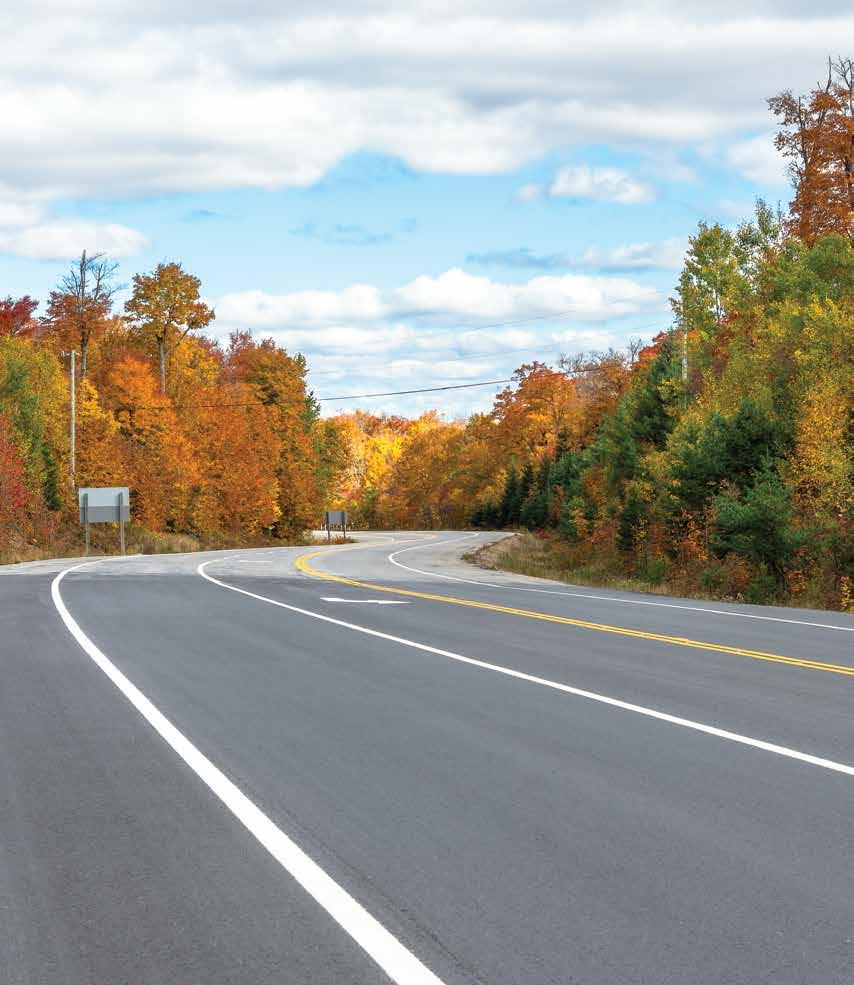
FALL 2022 | VOL35 | NO3 AC CONTENT getting more in the mix DESIGN GYRATIONS impact on mix durability

The official publication of the Ontario Asphalt Pavement Council, ASPHALTopics is published three times a year.
Ontario Asphalt Pavement Council 365 Brunel Road, Mississauga, ON, L4Z 1Z5
Tel: (905) 507-1107 Fax: (905) 890-8122 Email: info@onasphalt.org Website: www.onasphalt.org

Publications Mail Agreement #40011181
ADVERTISING
REPRESENTATIVE Patricia Abbas | 416.438.7609 | pabbas8@gmail.com
EDITOR Lara Henry | larahenry@sympatico.ca
DESIGN & EDITORIAL LAYOUT pdplante.com inc. | pdominiqueplante@gmail.com
COVER PHOTO Fall in Ontario. (©iStockphoto)
© 2022 All Rights Reserved.
SALES
05
07
09
10
16
22
26
28
33
34
36
39
40
43
44
46
48
50
FALL 2022 3
Chair’s Corner
Operations Corner
MarCom Matters
AC content: getting more in the mix
Design gyrations: impact on mix durability
Ontario RAP Report
2022 annual members’ golf tournament
Generation Alpha asphalt mixes and performance testing
2022 Asphalt Technical Symposium recap
Remembering Brian Keveryga
Fuel-resistant airfield mix at Pearson
Unsung Heroes
Technically Speaking
2023 Road Building Academy
Environmental Essentials
Commentary on Environmental Essentials
Industry News
The Last Word TABLE OF CONTENTS

CHAIR’s CORNER
Dominic Crupi Chair
The first and most important step toward net zero

Our environment and its future are one of the most contentious and difficult conversations we have on a regular basis. It’s so important because no one can deny that we, as a culture and community, need to do whatever we can to improve the way we live to intelligently reduce our impact on the environment. It is a difficult conversation to have because it is a difficult thing to do and a monumental task that will require sacrifice and an incredible amount of effort to accomplish real change.
A real solution for our industry will require collaboration, cooperation and considerable effort to effectively impact our environmental influence in a positive way, by both industry as well as those who purchase our products. One of the most important advances our industry has made is the ability to effectively, efficiently and reliably recycle asphalt back into our product through smart mix design, as well as adjustments to the virgin asphalt cement and aggregates we use.
Imagine the impact to the environment if even 10 per cent of the asphalt produced in our province consisting of sand, aggregate and asphalt cement does not need to be brought from an outside source to the production facility. In Ontario, we produce roughly 8.5 million metric tonnes of hot/warm mix asphalt on an annual basis. By recycling only 10 per cent on every tonne produced, we would effectively be reducing greenhouse gases emitted by our industry by taking the transportation of those materials off our roads and highways in the amount 850,000 tonnes of material or 21,000 trailer loads on the conservative side. This is a staggering number on its own, but let’s dive deeper.
It also means the virgin aggregates, which are a non-renewable resource, would last longer in our existing pits and quarries. This, in turn, also extends the life of these resources that are closer to our cities, reducing the haul lengths for the aggregates we do have to import to our plants. Now, in addition, consider the hundreds of thousands of tonnes of asphalt rubble that needs to be exported
from plants in addition to the number above because the properties our plants are on can only accommodate a limited number of material stockpiles if it is not processed and reused.
The next question we must ask is where that material goes if it can’t be reused. Will we end up in a situation as an industry where we are sending this asphalt rubble to landfill? How many other uses can we find for recyclable asphalt? Are those uses the most effective and environmentally-sensitive uses for that material? What are the costs opposed to the cost savings for tax payers and owners for recycling it responsibly back into our products?
OAPC has set targets for achieving the goal of NET ZERO which many industries are moving toward because it is a recognizable term that indicates to the public that substantial efforts and costs are committed to the goal. I would argue that our industry has zero chance of accomplishing this goal without the widespread acceptance of recycling asphalt. This will mean a concerted effort on the part of industry to supply a consistent and durable product as well as agencies in specifying and using recycled product if we are to move forward.
There are other strategies and changes we will need to make such as the use of alternative fuels in our heavy equipment and possibly even electric or hybrid uses once the technology gets there, but recycling is the single most important piece of the puzzle. The example of 10 per cent is an illustration of how a small portion of the mix can be a huge impact. Many owners allow some recycling currently, but it is so important that we work together to create specifications and processes that allow for us to recycle as much as we can while still producing reliable, quality material that is an excellent value for the end user. After all, how can producing a good product, while reducing our impact on the environment, be seen as anything other than what we absolutely have to do for our future and every future generation.
FALL 2022 5

OPERATIONS CORNER
Doubra C. Ambaiowei Director, Technical Services

Asphalt – a continuing quest for innovation in Ontario
The asphalt industry in Ontario is not new to the concept of innovation whether in materials, pavement and mix design technology, cutting-edge equipment and procedures, artificial intelligence, and more. Innovation encourages new thinking and advancements in design, production efficiencies, and construction of the most economical and environmentally-friendly pavements. In addition, improvements in health and safety at the construction site are helping the sector to meet all the current strict regulations across the province.
As new and familiar challenges present themselves, we must seek better ways to advance pavement sustainability by dealing with expectations not only from the perspective of climate change, but also with issues related to pavement quality, the use of Reclaimed Asphalt Pavement (RAP), and other aspects of the asphalt paving and road building industry in Ontario.
Recently, our sector, through OAPC’s leadership, has revisited the factors and ideas associated with producing and placing durable HMA pavements. We have consulted on the benefits and challenges with three-dimensional (3D) milling technology, and have made several research strides on our path toward performance testing of asphalt mixes, amongst other initiatives.
The 2022 OAPC Fall Asphalt Seminar (FAS) scheduled for Thursday, December 1, and themed “Innovations in Asphalt Technology: Materials and Paving Equipment” brings all of this important messaging together, allowing for education, re-education, information sharing, and guided discussions that support our continuing quest for innovation, and in realizing the highest-quality asphalt products. The agenda is loaded, and the in-person experience, being our first since the pandemic, is not one to be missed.
Many of the FAS presentations are featured in this issue of ASPHALTopics magazine. In Steve Goodman’s article, we revisit the fundamentals and discuss several innovative strategies and methodologies the asphalt industry can adopt or promote to improve the durability and performance of asphalt mix designs, and our recycling practices. This is complimented by updates from our latest industry study effort aimed at understanding the impacts of lowering laboratory design gyratory compaction effort (N des.).
A recap is provided on the proceedings from the 2022 OAPC Asphalt Technical Symposium, a platform that provides an effective space to communicate and collaborate on industry challenges and opportunities. The much-anticipated Ontario RAP Report is also unveiled — please be sure to read the report, and provide feedback. The collaboration between Good Roads and the OAPC will continue with the RAP survey completed on an annual basis. Finally, new updates and future plans pertaining to our spring 2021 ASPHALTopics feature on a fuelresistant asphalt mix is showcased. A continuing quest to be innovative builds resilience and guarantees good and better outcomes for everyone. It is my expectation that the asphalt industry in Ontario will remain resolved to see innovation as a way of life, a culture, and as a healthy practice — this means we must be open and eager to learn and unlearn new approaches and methods.
This issue of ASPHALTopics magazine provides much more than the focus on OAPC’s FAS. Endeavour to read and digest every detail. As always, I look forward to hearing from you pertaining to all things asphalt. Do enjoy the fall activities, and I wish you an enjoyable yuletide!
FALL 2022 7
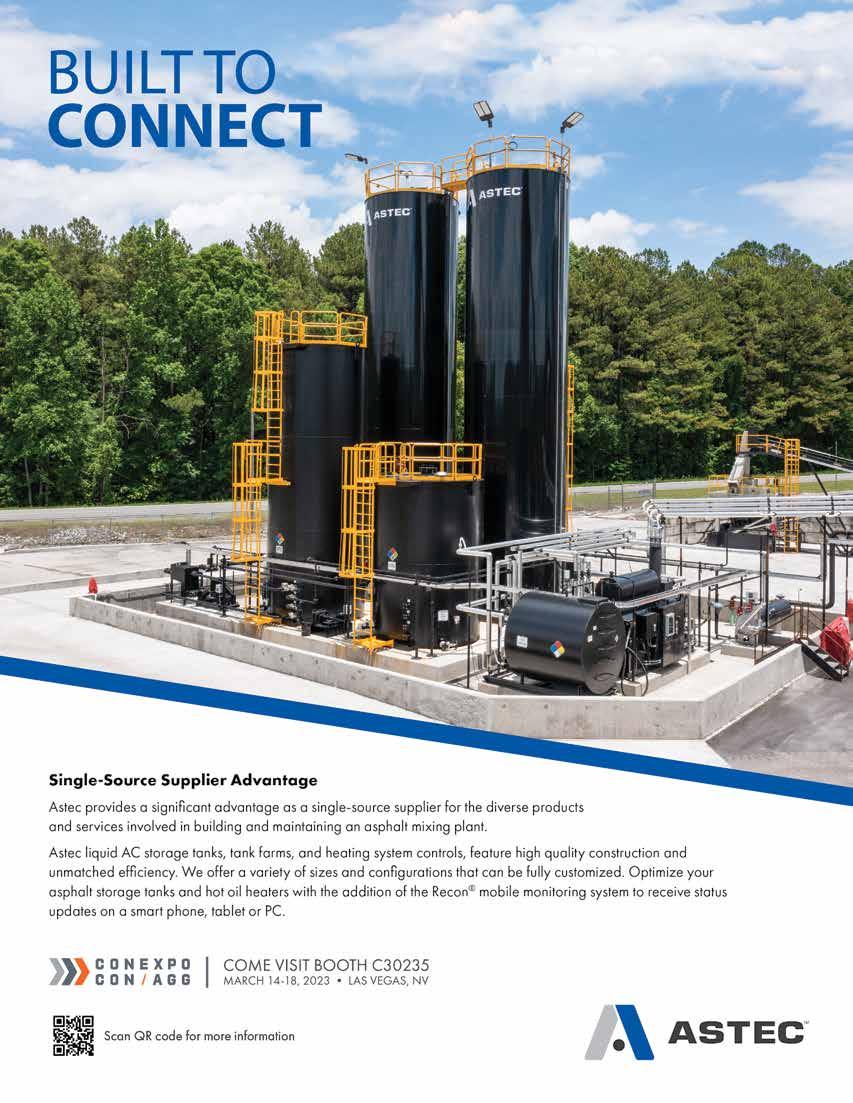
MARCOM MATTERS
John Provenzano Director, Marketing & Communications

The time has come for an OAPC logo refresh and a new visual identity. Refreshing a logo, instead of creating a new logo, is less dramatic. Think of it as a logo makeover that works with design elements that are already in place. A refreshed OAPC logo will see the designer make small shifts to what’s already there by adding messaging, updating colours, or simplifying the entire look and feel.
A new website, logo and visual identity are on the way for OAPC!
The MarCom team is currently in the process of planning, designing, and assisting in building a new harmonized website for ORBA and OAPC. These websites have been specifically designed to help advocate for Ontario’s transportation infrastructure and paving industry. To add to the excitement, we’ve also been given the green light to design a new logo and visual identity that will further enhance the OAPC brand.
A new website can help communicate OAPC’s brand value proposition and will convey professionalism. It also extends the council’s reach across Ontario, Canada and North America. The new website will engage visitors through a narrative. Gone from the old website are long dropdown menus that have visitors going down a rabbit hole to find information. The new OAPC website will have users navigate our site’s pages while building a story that is unique to each visitor. There are lots of ways to create a narrative, but the best experiences are natural ones that lead through design and layout.
The new site will include an updated plant locator with filtering and search features. A resource library will be built making it easy to find and utilize the vast resources and research that OAPC has already produced. A new Job Portal will also be included in the re-design, as well as a new searchable member-updated Sourcebook, where members can find other members, will replace the old PDF format that became obsolete as soon as it was published. Furthermore, there will be a greater focus on how we can increase OAPC award nominations and the visibility of the Trillium Award program by implementing an online tool.
A new OAPC visual identity will see a collection of innovative visual elements that will serve to represent and differentiate our brand. Along with a logo refresh, you’ll see new colours that will help our stakeholders identify our brand. Our new logo and visual identity will build on the foundation of the council’s brand identity as outlined in our new brand style guide. A visual identity reinforces our core values and brand promise through visible media. Using consistent and strategic visuals help to communicate a strong visual identity and helps tell our brand story. Over time, continued exposure of our brand will foster associations and create emotional responses, oftentimes triggered by visual cues.
The website will be the most onerous project, and so far we have already defined the requirements through a discovery workshop, scheduled meetings with stakeholders, conducted a gap analysis, and gathered data and analytics for research and analysis. On the design side, we’ve confirmed and consulted with various audiences, and performed a content audit. We’re at the point now where the first round of wireframes have been completed and we’ve begun visual and user experience designs. The next step is to integrate the new logo and visual identity for layouts, colours, fonts, menus and iconography, and source imagery. We are confident that the website will be launched in the first quarter of 2023. I can’t wait to show you what we’ve done!
FALL 2022 9
by Stephen N. Goodman

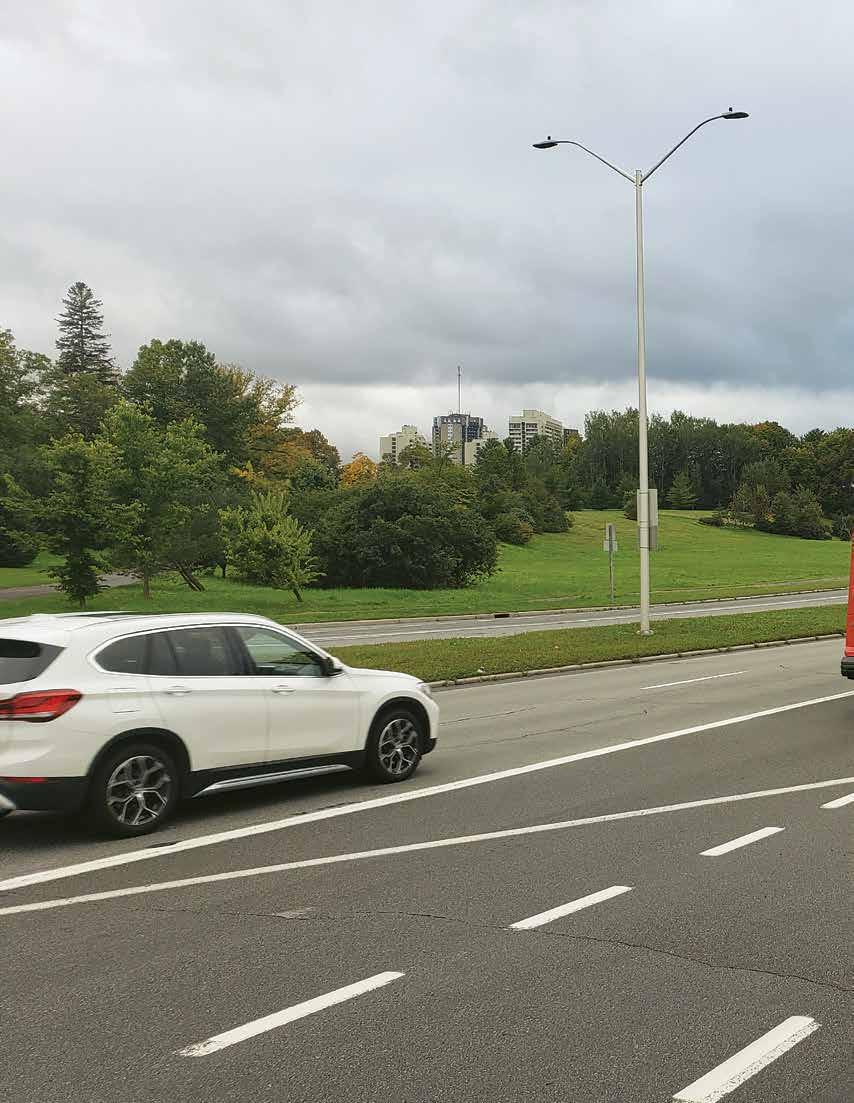
10 OAPC | ASPHALTOPICS
Determine the correct amount, put in the correct amount, then put in more
As you know, there continues to be considerable debate as to how best to get more asphalt cement in the mix, but we first need to ask ourselves why we want to do this. That’s an easy one – we want our pavements to last longer or at least as long as we think they should. Lately, it seems as though our roads are aging more quickly, cracking and raveling, then potholing and ultimately requiring replacement long before 20 years have elapsed. As a pavement designer, this is disappointing, and as a taxpayer, it is infuriating given that we already have a major infrastructure replacement deficit. We need to find ways to make our asphalt concrete last. ››
A bus-only lane in Ottawa, paved with Superpave 12.5 Traffic Level E with PG70-34 asphalt cement, has no rutting after two summers in service.
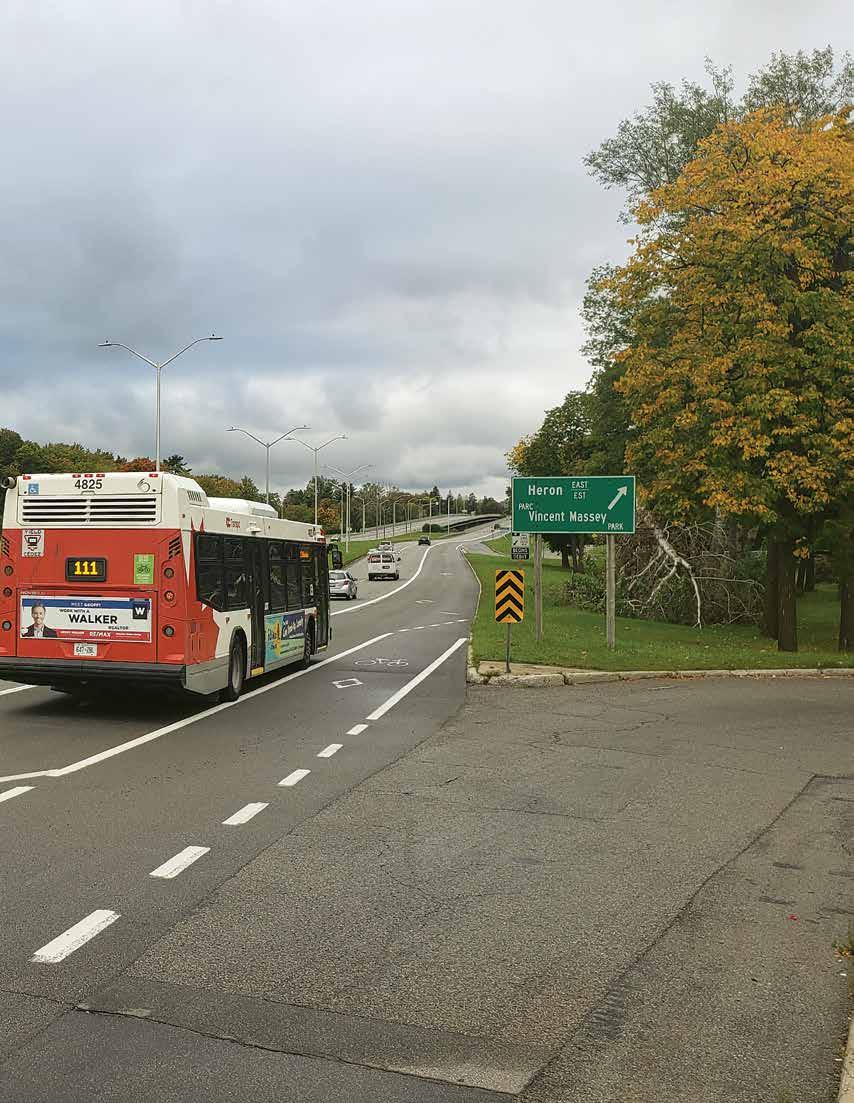
FALL 2022 11
The quest for improved durability is not unique to Ontario. Fortunately, we have some tools that can be quickly and easily implemented.
MAKE SURE WE DETERMINE THE “CORRECT” ASPHALT CEMENT CONTENT
Before we discuss adding more asphalt cement to the mix, let’s make sure we are putting in enough to begin with because I’m not convinced that we are. Many people blame the Superpave mix design system for reducing asphalt cement content. Remember that when Superpave was first developed in the 1980s and 1990s, permanent deformation (i.e. rutting) was a major concern. The Marshall method was unable to consistently produce mixes that could resist heavy traffic. The introduction of the Superpave Gyratory Compactor (SGC) allowed mixes to be tailored to the anticipated traffic volumes while ensuring sufficient asphalt cement content via minimum criteria for Voids in the Mineral Aggregate (VMA). Superpave has been extremely successful, to the point where rutting is no longer a concern. But does this success have to come at the expense of durability? Should we go back to the Marshall mix design and hope for the best with respect to rutting? I would argue no. I can think of three primary reasons why our mixes are aging prematurely:
1. We put too much stock in VMA and not enough in Volume of Effective Binder (Vbe), which is the actual amount of glue available to hold the mix together and give it durability;
2. The current Ontario Provincial Standard Specification (OPSS) 310 thresholds for asphalt cement content acceptance are too wide and we are accepting underasphalted mixes; and

3. We design our mixes to 4 per cent voids in the laboratory, but compact to 8 per cent in the field. This leads to increased permeability to air and water, which results in accelerated aging.
Anyone reading this article knows that asphalt cement (hot, warm, or cold) is a complicated material. That said, it has only three ingredients: air, asphalt cement, and aggregate. The complexity arises from the properties of the asphalt cement itself (not discussed herein), and the interaction between the asphalt cement and aggregate gradation in a compacted state commonly referred to as the “volumetric properties.” As already indicated, the current Superpave mix design puts too much emphasis on VMA, which is simply Vbe plus air voids. But air doesn’t hold the aggregates together. It is true that some amount of air is required to resist permanent deformation, but not strictly 4 per cent in the laboratory and certainly not 8 per cent in the field. The only way to ensure durability is to ensure sufficient Vbe. Much of the problem surrounds accurate determination of the percentage of absorbed binder (Pba). Determination of Pba depends upon four individual parameters, as shown below:
Pb is the asphalt binder content by mass, Gb is the specific gravity of the asphalt binder, Gmm is the maximum theoretical specific gravity of the mix, and Gsb is the bulk specific
Pba = Gse = * Gb Gse Gsb Gse * Gsb 100 Pb 100 Pb Gmm Gb
durability
Volume
Effective
12 OAPC | ASPHALTOPICS
The only way to ensure
is to ensure sufficient
of
Binder (Vbe).
gravity of the aggregate blend (Gse is the effective specific gravity of the aggregate blend). Of these four variables, Gerry Huber and Bill Pine at Heritage Research Group tell us that Gsb has the greatest effect on Pba1 Review of the equations above and the consistency of Pb and Gb suggest that this is true.
So what happens if the actual Gsb is lower than the design value? Referring to the equations above, the Pba value calculated is then artificially lowered and some of the asphalt binder is incorrectly assumed to be effective (Vbe) when really it has been absorbed. This artificially increases VMA because the Vbe is inflated. In reality, the mix is under-asphalted and will have reduced durability. Now, no one is suggesting that a mix designer would use an inflated value of Gsb to meet VMA requirements, but regular quality control testing and confirmation of Gsb by the aggregate supplier (and agency) is one way to ensure adequate asphalt cement in the mix.
MAKE SURE WE PUT IN THE “CORRECT” AMOUNT OF ASPHALT CEMENT

If our Gsb value is accurate and we now know how much asphalt cement should be added for good durability, why do we accept less? Because OPSS allows us to do so. Specifically, the acceptance thresholds in OPSS 310 Table 7 permit
Figure 1. Hot mix asphalt sample test results vs. mix design.
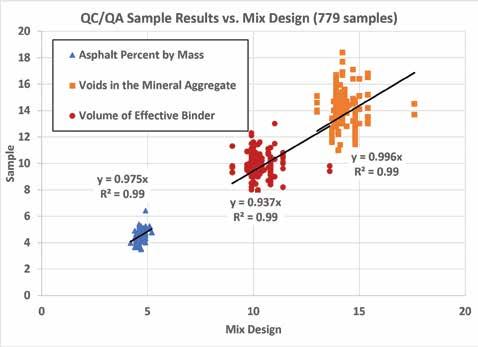
a reduction of 0.3 per cent asphalt cement for full acceptance and up to 0.5 per cent reduction for borderline acceptance. As many municipal paving projects may only take one or two samples, this means that a mix designed to 5.0 per cent asphalt cement will be considered acceptable with as little as 4.5 per cent! The aggregate absorption remains the same, so a 0.5 per cent reduction in asphalt cement by mass results in a reduction of effective binder volume (Vbe) of about 1.1 per cent. As the minimum design volume of asphalt cement for a 12.5 mm Superpave mix is 10 per cent, a reduction of 1.1 per cent is considerable. The mix is under-asphalted and will have reduced durability.
How do I know that HMA suppliers are under-asphalting? Take a look at Figure 1. I analyzed 779 hot mix asphalt samples tested by our laboratory between 2019 and 2021, and looked at the actual VMA, asphalt cement content, and effective asphalt ››
FALL 2022 13
BUILDING ON STRONG FOUNDATIONS Leading Ontario’s Transportation Future 96th ANNUAL ONTARIO ROAD BUILDERS’ ASSOCIATION CONVENTION & AGM FEBRUARY 5 – 7, 2023 · Fairmont Royal York, Toronto
1 Gerry Huber and Bill Pine. “Measurement of Effective Asphalt Content: Understanding How Much is Present.” Proceedings, Canadian Technical Asphalt Association (CTAA), 61 (2016).
binder volume as compared to the Job Mix Formula (JMF). These include Superpave 12.5, Superpave 19, and HL3 Fine. As shown, the overall average VMA is the same between the samples tested and the JMF (although there is quite a range). So why are mixes aging prematurely? Look at the asphalt cement content — on average the HMA suppliers are only putting in 97.5 per cent of the JMF value. In school, 97.5 per cent was a good score, but remember that AC content is by mass. When the effective volume of asphalt binder (Vbe) is calculated, the mixes are only getting 93.7 per cent of the required effective asphalt cement. Again, the mixes tend to be under-asphalted and will have reduced durability.
So why are HMA suppliers underasphalting (on average)? A nefarious supplier might take advantage of the fact that they are paid based on JMF asphalt cement content and not QA acceptance. The more likely reason, however, is that they are terrified of low laboratory air voids, also known as the “VMA Collapse.”
An HMA plant is not the same as a laboratory mixer. When aggregates are dried and mixed in the plant, a large amount of dust is generated. As such, mixes tend to have a greater percentage of dust than the mix design, which reduces VMA on a 1:1 ratio. The correct solution to this problem is to adjust the gradation to provide more voids; however, the common solution is to reduce AC content. It is therefore my opinion that the OPSS 310 acceptance tolerances for asphalt cement content be changed to -0.1 per cent on the negative side. It’s much better to accept a slight increase in AC content and reduced air voids than under-asphalting the mix. And make sure you pay your HMA supplier for the asphalt cement that they actually put in the mix.
Now it is time to address the elephant in the room. We design our mixes to 4 per cent air voids in the laboratory, but allow up to 8.5 per cent air voids in the field (i.e. 91.5 per cent). This simply doesn’t make sense. Permeability to air and water is greatly increased, which leads to accelerated aging. Reconciliation of laboratory and field voids may never happen because the compaction
Figure 2. Comparison of AC content and volumetric properties at 3.5 vs. 4 per cent air voids.
equipment is completely different. However, increasing AC content is certainly one way to increase field compaction.
NOW PUT IN A LITTLE MORE
The correct amount of design asphalt cement has been determined and the HMA supplier is actually putting in that value. Let’s look at ways to get more asphalt cement into the mix. As with many things in life, the solution tends to be simple. Just put more in!
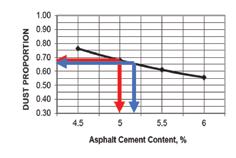
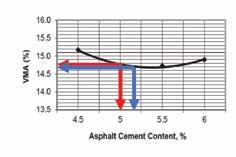


Thanks, Captain Obvious, but how do we do that? It’s actually pretty straightforward. Every year, our HMA suppliers send us a 20-page package for each mix design they prepare. Turn the page. Everyone simply reviews the first page to see if the design meets OPSS 1150 or 1151, but there are a series of graphs plotting volumetric properties versus asphalt cement content. It is my experience that asphalt cement content can
Figure 3. Ottawa bus lane shows no rutting after two summers even at bridge deck expansion joint.

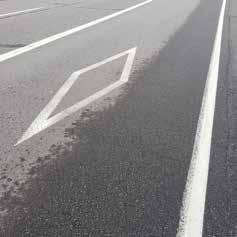
14 OAPC | ASPHALTOPICS
usually be increased by 0.2 per cent with a small reduction in laboratory air voids. Take a look at Figure 2 for a typical Superpave 12.5 mix.
This approach is commonly referred to as Regression Mix Design. The Ontario Ministry of Transportation (MTO) has a number of projects whereby the design asphalt cement content at 4 per cent voids is increased (subject to meeting specifications) by reducing the laboratory air voids to 3.5 per cent while maintaining VMA. Could we go lower than 3.5 per cent air voids? Likely, but this is a great start. Between 2019 and 2021, MTO constructed 16 projects using regressed mixes. Average AC content increased by 0.2 per cent, average laboratory air voids were maintained within specification, and average field compaction increased to between 93 and 95 per cent. This is an excellent formula for increased durability. Will rutting increase? Not likely, because we still have adequate voids, particularly in the field. Also, the risk of rutting is greatest immediately after paving. After one to three years in service, MTO is not reporting issues with rutting of regressed mixes.
In Ottawa, a bus-only lane was paved with Superpave 12.5 Traffic Level E with PG7034 asphalt cement in 2021 (Figure 3). Due to issues at the plant, the mix contained slightly excess fines resulting in low laboratory air voids (1.8 per cent). Field compaction was good at 95 per cent. After two summers in service under punishing bus traffic, there is no rutting even at the bridge deck expansion joint (Figure 3).
I think we’re on to something here, particularly since minimal changes to OPSS standards are required. The key is to stop thinking of 4 per cent laboratory air voids as some sort of sacred value. Mixes don’t simply rut because they have 2.9 per cent air voids. This is where performance testing comes into play. It is certainly an exciting time to be a mix designer and specifier. There are a number of different tests available including the Hamburg Wheel Tracking test, Asphalt Mixture Performance Test (AMPT), and IDEAL-RT for assessing rutting potential, as well as the IDEAL-CT,
Semi-Circular Bend (SCB), and Overlay Tester for assessing cracking potential. The future of asphalt mix design will include performance tests for rutting and cracking. In the meantime, make sure you are putting in enough asphalt cement, then add a bit more. I think you’ll be happy with the results.
Dr. Goodman, Ph.D., P.Eng., is Manager of Pavements and Materials with GEMTEC Consulting Engineers and Scientists Limited where he provides asphalt and pavement engineering expertise to 13 offices across Ontario and Atlantic Canada. Since 2006, he has also been the editor for the Canadian Technical Asphalt Association (CTAA).
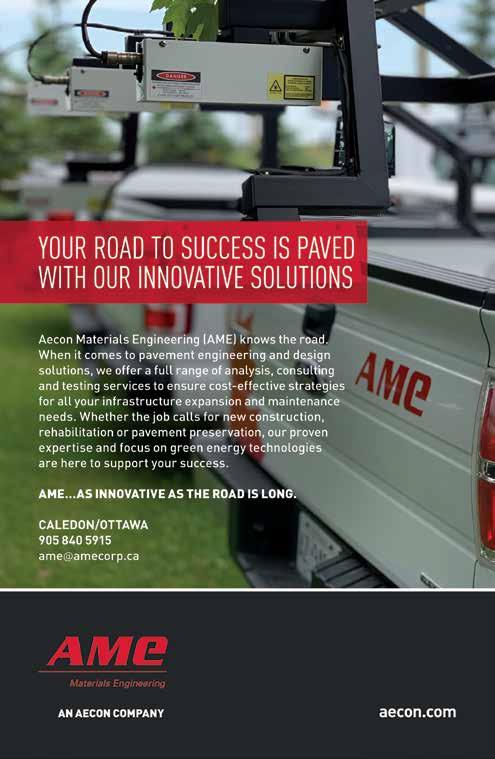
FALL 2022 15
The introduction of Superpave technology in Ontario has provided a possibility to improve volumetric mix design methodology and enhance quality requirements for aggregates used in hot mix asphalt (HMA) mixes. Superpave mix designs have significantly improved the performance of pavements in terms of resisting rutting, shoving and flushing on high-volume highways, major arterial roads, intersections and bus lanes.
However, there are concerns among agencies that the asphalt cement content of many Superpave mix designs may have been reduced to below optimal levels for durability. Asphalt content, or more specifically, effective asphalt content of HMA mixes, has significant influence on pavement performance in terms of fatigue and thermal cracking. We have to be certain that any changes made do not adversely affect other aspects of durability such as rutting.

16 OAPC | ASPHALTOPICS
by Doubra Ambaiowei
There are several strategies to optimize asphalt cement content for improved mix durability. However, the focus here is by lowering laboratory design gyratory compaction effort (Ndes.). Higher traffic category roadways (Traffic Category C, D and E) require higher gyration levels. The higher gyration levels tend to reduce the amount of space available for asphalt binder in the mixes and yet still meet the specified volumetric properties. It has been suggested that lowering the gyrations for Category C, D, and E mixes will result in additional asphalt cement in the mix. This would only be true if the gradations were fixed.
There is an additional concern that reducing gyrations may increase rutting. However, many mixes reach a “locking point” defined as the gyration at which the aggregate’s skeleton locks together and further compaction may result in aggregate gradation degradation and very little additional compaction. The locking point will have an impact on the required aggregate properties. Some agencies, such as the Illinois DOT, have used
this concept to limit gyrations for certain mixes. However, it is difficult to specify as the number of gyrations to the locking point will likely increase as asphalt cement content increases due to the added lubrication. Fine graded mixes are typically less susceptible to aggregate degradation.
With this knowledge, and the outcome from the 2018 ORBA/ OAPC Quality of Asphalt Review, OAPC has sought to find a balance between rutting and cracking to improve the cohesive properties of asphalt mixes produced and placed for Ontario’s cold climate and further advance the reviews’ recommended asphalt cement content values of 0.5 to one per cent higher at least in reference to the current ranges of 4.5 to 5.0 per cent.

These objectives have since gained some traction through a collaborative study involving OAPC and two industry partner laboratories. The study investigated the impact of lowering the laboratory design gyratory compaction effort from 125 to 100 gyrations for Category E and D. The impact of the changes on performance were further evaluated using laboratory tests including the Flexibility Index by Semi-Circular Bend (SCB) test, Disk-shaped Compact Tension (DCT) test, and Hamburg Wheel Tracking (HWT) test.
STUDY METHODOLOGY
The study methodology included an initial review of current and past mix designs for designs that used the exact same aggregates to produce mixes for both traffic categories D and E. This helped to mine existing data to review the impacts of ››
FALL 2022 17
reduced gyrations, as well as informed the desire to evaluate the typical Ontario Superpave 12.5 mm NMAS mixes. Aggregate sources such as granite, limestone and dolomitic sandstone were initially investigated by determining the optimum AC contents at 4 per cent air voids based on three trial points (4.5, 5.0 & 5.5 per cent). However, due to concerns of variabilities in some reported volumetric parameters, poor performance on the Hamburg, and a general lack of testing resources, the laboratory exercise was discontinued for these sources.
The latest study efforts adopted a SP12.5FC2 Category E traprock mix design at 5.0 per cent AC, incorporating PGAC 70-28 XJ meeting Ontario Provincial Standard Specification (OPSS) 1101 and compacted at temperatures between 135 and 142°C, believing that the skeleton it provided might be the best approach. This article summarizes the outcomes and next steps of the study efforts. A comprehensive discussion of the study methodology and other outcomes from the study is available in a 2022 Canadian Technical Asphalt Association (CTAA) conference paper entitled “Lowering Design Gyrations and Impact on Mix Durability.”


VOLUMETRIC VERIFICATION OUTCOME
The outcome from reducing design gyration for Category E traprock mixes from 125 to 100 highlighted a difference in AC content between Category E and D at approximately 0.3 per cent (Figure 1). This was found to be consistent with the earlier unpublished work completed in 2021 that incorporated a granite aggregate source. The AC gains from reduced gyrations for Category E granite, limestone and dolomitic sandstone mixes were 0.34, 0.17 and 0.20 per cent respectively, while Category D dolomitic sandstone mix was 0.21 per cent.
PERFORMANCE TESTING OUTCOME
Per the volumetric approach adopted in the study, with each laboratory data suggesting an average of 0.3 per cent

18 OAPC | ASPHALTOPICS
Figure 1. Optimum asphalt cement content between laboratories and across traffic groups.
Figure 2. Average fracture energy from Illinois Flexibility Index Test (IFIT) using Semi-Circular Bend (SCB) geometry.
Figure 3. Rut depth results after 20,000 passes (Laboratory B).
increase in AC content, a balanced mix design approach was adopted for performance testing. This involved keeping the aggregate skeleton the same, selecting an optimum AC content of 4.80 per cent for the control/cat E mix, and changing the AC content by ± 0.3 per cent for the lower and upper limits respectively. Performance testing was completed in strict adherence to instructions from the MTO IFIT-SCB correlation and DCT-Hamburg mini correlation program. The IDEAL CT and RT tests were also introduced as QA friendly tests for the SCB and HWT test findings.

Figure 2 illustrates the average Fracture Energy from SCB I-FIT results between Labs A and B.
Fracture energy reported by Lab A suggests increments with respect to increasing AC percentage, whereas Lab B shows a decrease in Fracture energy as the AC percentage increases. The trend of the results, with similar representation in average strength, flexibility index, and post-peak slope (see 2022 CTAA conference paper), suggests that the variations between laboratories is likely due to a difference in specimen air voids. AC increments could be beneficial to improved cracking resistance. However, it is possible that this minor differential could simply be a case of sensitivity to the air voids, and not to the asphalt content or PGAC grade. Higher air voids are likely to result in mixtures with lower fracture energy.
Figure 3 summarizes the HWT rut test results reported by Lab B, with depths achieved after 20,000 wheel passes (10,000 cycles). The trend suggests rut depth increases as AC percentage increases. However, results at less than 6 mm are satisfactory and conform with typical results for the Hamburg on SP12.5FC2 mixes with 64-YY and 70-YY PGACs, which have been observed in the range of 4 to 8 mm after 20,000 passes (10,000 cycles).
Figure 4 summarizes DCT test results reported by Lab B. The larger the fracture energy, the better the cracking resistance of the asphalt mixture. A MNDOT study suggests a minimum of fracture energy of 400 to 600 J/m 2 (depending on project level) for protection against thermal cracking with fracture energy in the range of 350 to 400 J/m 2

considered borderline1 . DCT test results reported in this study are considered sufficiently flexible to withstand low temperature cracking. The trend suggests higher fracture energies on the upper and lower limits of the optimum AC percentages. Repeating the test at -24°C may offer better differentiation of the findings.
Figure 5 illustrates findings from IDEAL-CT reported by Lab B. Like the IDEAL-RT, it is considered to be a simple performance test that Ontario can implement to confirm repeatability, sensitivity to changes in mixture properties and correlation to field performance. The larger the CT index , the better the cracking resistance. CT index results reported in this study were found to increase with increasing AC percentage, with the highest index recorded on the upper limit of the optimum AC, suggesting better cracking resistance can be derived with this mix type.
Like the HWT test, the IDEAL-RT test is performed at 50°C. The test provides the maximum shear resistivity of the asphalt mixture known as the RTindex. The higher the RTindex value, the greater the material’s resistivity to shear deformation. ››
Figure 5. Indirect Tension Asphalt Cracking Test (IDEAL-CT) Test Results (Laboratory B).
Figure 4. Disk-shaped Compact Tension (DCT) Test Results (Laboratory B).
FALL 2022 19
1 Newcomb D., Zhou F., “Balanced Design of Asphalt Mixtures”. Research Report, Texas A&M Transportation Institute for Minnesota Department of Transportation, Report No. MN/RC 2018-22, June, (2018).
Figure 6 summarizes results of the average RT index from IDEAL-RT test reported by Lab B.
The trend from HWT suggests higher RT index on the lower and optimum AC percentages. However, it should be noted that the results at the optimum AC (4.8 per cent) are based on only one completed test, whereas the lower and upper optimum AC limits provide the average result from two completed tests. In comparison to the trend from HWT test results and the IDEAL-RT test in this study, there is good correlation between the mix-material performance (shear resistivity) at the lower and upper optimum AC limits, with higher RT index translating into lower rut depths, respectively.

CONCLUSIONS AND NEXT STEPS
It can be inferred from the study outcomes that a low design gyration on Superpave CAT E Traprock aggregate mix -type could effectively create mixes that will stand design traffic loading without rutting and cracking. Implementing a balanced mix design (BMD) system, with an appropriate performance testing mechanism, could be the key to improving the cohesive properties of asphalt mixes in a cold climate like Ontario. The results from this study support the recommendations from the Quality of Asphalt Review that asphalt cement contents values of 0.5 to one per cent higher could be beneficial to production and placement of more durable asphalt pavements. However, this must be validated across the various aggregate sources in use in Ontario.
Opportunities exist to investigate plant-produced granitetype mixes. In the 2021 unpublished industry study, limestone and dolomitic sandstone mixes suggested no significant increments in AC content from reducing design gyration levels. However, from an alternate aggregate source perspective, some appreciable variations are evident. As such, it may be worthwhile to confirm how these types of mixtures hold up with performance testing. All stakeholders in Ontario are invited to commit more to the quest for quality asphalt roadways, and this study is a continuing effort in that direction.

20 OAPC | ASPHALTOPICS
Implementing a balanced mix design (BMD) system, with an appropriate performance testing mechanism, could be the key to improving the cohesive properties of asphalt mixes in a cold climate like Ontario.
Figure 6. Indirect Tension Asphalt Rutting Test (IDEAL-RT) test results (Laboratory B).
 by Amin Mneina
by Amin Mneina
ONTARIO RECLAIMED ASPHALT PAVEMENT Report
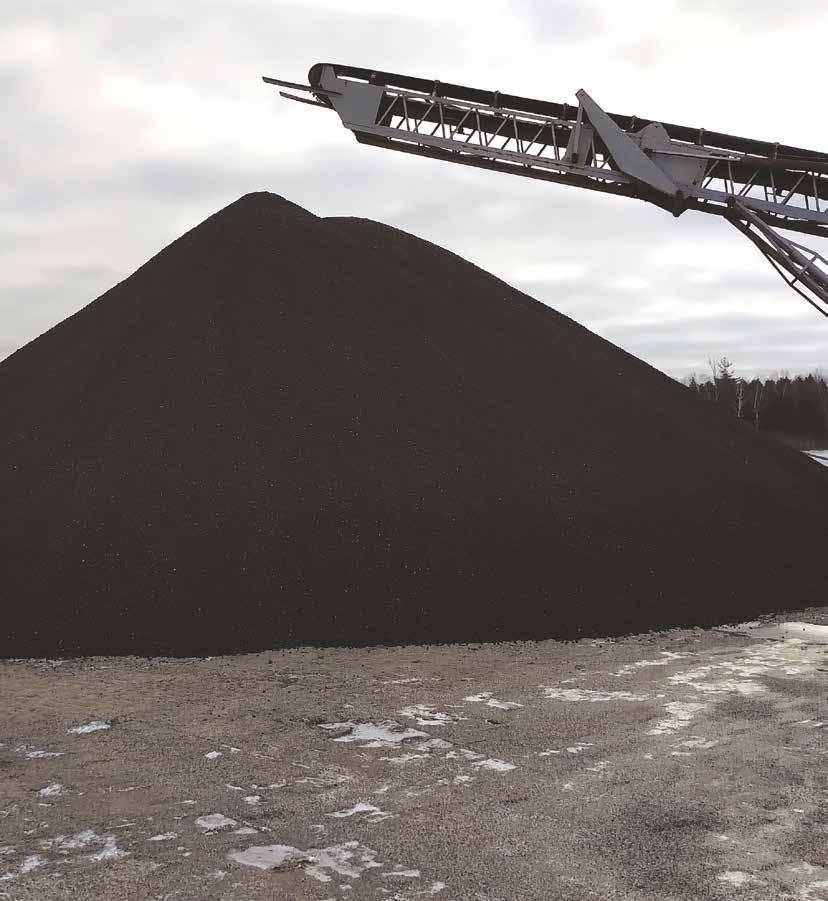
Private and public sectors partner towards sustainable paving
The road-building industry has great potential to further our progress towards sustainability and carbon neutrality by recycling asphalt pavement. First, we need to be on the same page about what sustainability means. Our collective understanding of the concept of sustainability has crystallized into a more comprehensive connotation. In 1987, the Brundtland Commission of the United Nations defined the term Sustainable Development as “development that meets the needs of the present without compromising the ability of future generations to meet their own needs.” At the 2005 World Summit on Social Development, the detailed goals of sustainability were set as a balance between Economic Development, Social Development, and Environmental Protection.
22 OAPC | ASPHALTOPICS
how implementing best practices in managing RAP can play a significant role in unlocking huge sustainability potentials in Ontario’s road-building industry.
The construction and maintenance of pavements consume more than 6.5 million tonnes of asphalt cement and 75 million tonnes of aggregates each year in Ontario. Both these resources are considered non-renewable and should be consumed strategically to maximize sustainability. Using RAP in road paving is one of several tools we have in our sustainability toolbox — we just need to learn how to make the most of it.
Through the Ontario RAP Survey initiative, Good Roads (GR) and the Ontario Asphalt Pavement Council (OAPC) have obtained a baseline for RAP quantities in Ontario. Continuation of such measurements is paramount to monitor and evaluate our progress towards achieving our sustainability ambitions through the use of RAP.
Table 1 presents quantities of unprocessed RAP inventory in Ontario and the number of facilities scanned. Mneina & Smith (2019) estimated the amount of processed RAP in addition to the unprocessed RAP piles using satellite imaging, as well as the amount of RAP in locations with poor image quality, and reported a total estimate of 6.7 million tonnes of RAP in Ontario for 2019 (see Figure 1). In 2021, it was reported that there was a facility total of around 3 million tonnes of unprocessed RAP based on the facilities surveyed. ››
FALL 2022 23
Facilities Scanned Unprocessed
Facilities
Unprocessed
6.4 Million Tonnes of conserved virgin aggregates (8% of
annual infrastructure use) 1,565 lane kilometers of extra paving 2M bbl of bitumen cement (335K Tonnes) 15 million m3 of conserved fresh water 125 Thousand Tonnes of GHG that are not emitted 530 K Dump trucks Windsor to Ottawa and back! $270 million in savings 56.5 K Household for 1 year
Geo-Zone 2019 2020 2021
RAP (Tonnes)
Scanned
RAP (Tonnes) Facilities Scanned Unprocessed RAP (Tonnes) North 5 868,418 5 299,000 4 27,500 Southwest 7 263,007 4 287,296 7 370,269 Central 37 1,901,174 21 1,434,510 32 1,815,253 Southeast 8 1,280,015 9 260,000 17 739,899 FACILITY TOTAL 57 4,312,614 39 2,280,806 60 2,952,920 Table 1. Unprocessed RAP quantities in Ontario.
Ontario’s
Figure 1. 2019 RAP quantities in Ontario presented based on its sustainable value (Mneina & Smith, 2019). ost recently in 2021, Canada announced its commitment to achieve net-zero emissions by 2050 through various initiatives with an emphasis on a circular economy and the reduction of waste. To help the road-building industry meet these objectives, this article will introduce the Ontario Reclaimed Asphalt Pavement (RAP) Report which discusses
M
By surveying Ontario municipalities, it was found that using RAP in HMA is the most popular recycling technology in municipal paving as presented in Figure 2.
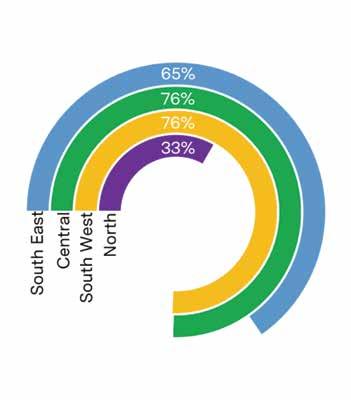
Even though municipalities already utilize recycling technologies in paving operations, there are still specifications used by many jurisdictions that do not allow the use of RAP as presented in Figure 3. The number one reason agencies do not allow use of RAP is lack of trust in the handling and production process. Ensuring performance quality of the end-product starts at the source. While there are numerous RAP best practices in North America, there are no specific guidelines, specifications, or practice guides for RAP stockpile management in Ontario. Hence, a primary objective for the Ontario RAP Report is to synthesise information on best practices for RAP processing and stockpile management through collaboration with Ontario’s largest and most experienced HMA producers and contractors.

The last section of the Ontario RAP Report is focused on RAP Source Best Practices which provides recommendations on limiting
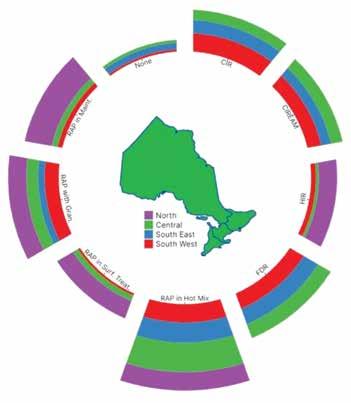
24 OAPC | ASPHALTOPICS
Figure 2. Most popular pavement recycling technologies in Ontario municipalities.
Figure 3. Municipal specifications on RAP use in Ontario (percentage refers to municipalities that allow the use of RAP in their specifications).
variabilities in RAP properties, improving quality of incorporated mixes, and increasing RAP processing productivity and reducing maintenance costs. It covers three main areas in managing RAP stockpiles: Stockpiling, Processing/Crushing, and Sampling & Testing. Synthesised information provides the means for producers to cut down up to 6 to 12 per cent of energy costs through a multilayered approach for reducing moisture in RAP stockpiles — for example, utilizing small individual stockpiles of processed RAP to allow for more efficient drying. Infrastructure owners would also benefit from limiting moisture in RAP since minimizing RAP moisture would ensure better bonding during the mixing process and minimize the risk of blisters in the paved mat.
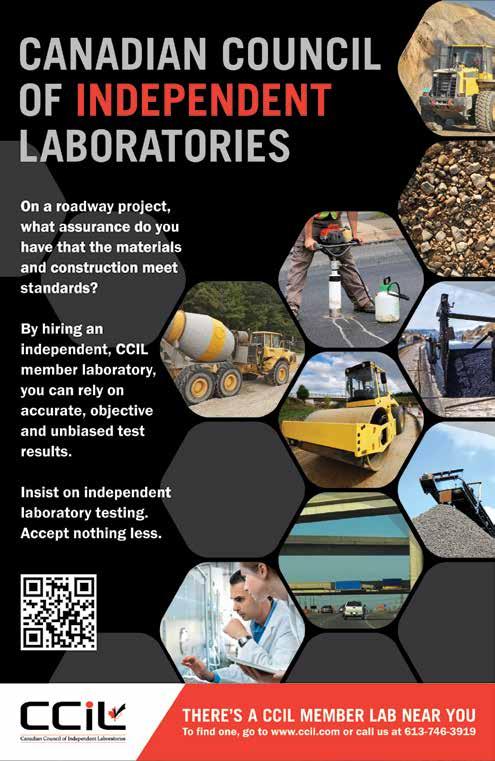
Other information in the report also provides the means to increase productivity and reduce maintenance costs through appropriate selection of crushing and processing equipment and methods. For instance, using improper crushing equipment (such as jaw or cone crushers) to crush RAP results in splitting aggregate particles and altering the gradation rather than breaking RAP agglomerations. Crushing the aggregate creates white rock that changes the mix volumetrics as it requires additional asphalt cement to coat the new particles.
The Report will be made available to the public at no cost and will be distributed to stakeholders by the partner organizations. You may access the report online at onasphalt.org/ Publications & Education
Public/private partnerships with common goals are the key to making any measurable progress towards sustainability. Good Roads (formally known as the Ontario Good Roads Association/OGRA), together with OAPC, the Municipal Engineers Association (MEA), and the Centre for Pavement and Transportation Technology (CPATT) at the University of Waterloo, have proven to be successful in advancing
sustainability goals in municipal paving and developing the Ontario RAP Report. The Report will be updated annually and is intended to provide a sound evidence base for promoting the economic and environmental benefits of using RAP in road building across Ontario.
FALL 2022 25
Amin Mneina is Coordinator, Technical Programs & Research, for the Good Roads/ Municipal Engineers Association.







26 OAPC | ASPHALTOPICS
2022 ANNUAL MEMBERS’ GOLF TOURNAMENT


Held at the Station Creek golf course in Gormley on August 17, the sold-out ORBA/OAPC Annual Members’ Golf Tournament returned after a two year hiatus. A special thank you to all the attendees and our sponsors for making this such a successful day.



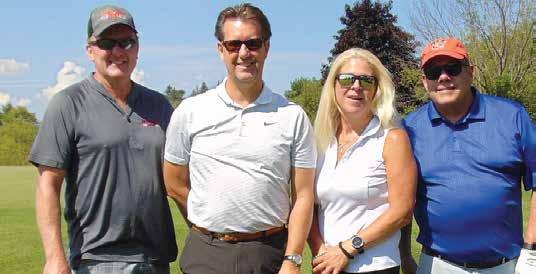 by Sina Varamini
by Sina Varamini

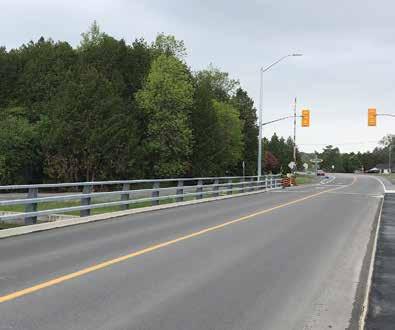
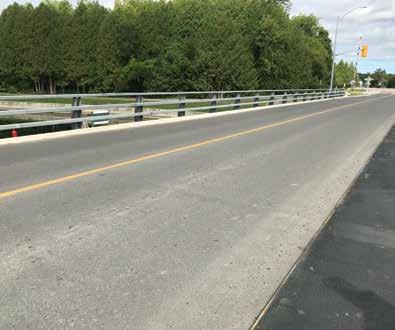

28 OAPC | ASPHALTOPICS
September 2020 June 2021
GENERATION ALPHA ASPHALT
PERFORMANCE TESTING
MIXES AND
Figure 4 – Low permeability performance-based bridge deck mix over the span of 4 years. May 2019
If you have children or grandchildren born in 2010 or later, congratulations. You have a Gen Alpha in the family. Members of this generation were born when rapid advances in technology — the internet, apps, and smart phones — had become the necessary tools of daily life. Unlike many of us in the older generations, these kids adapt flawlessly to new technology and eagerly await the next technological advancements. I would have never imagined my 16-monthold daughter, Ava, could unlock my smart phone and access Netflix to watch cartoons! They learn that quickly.
Gen Alpha kids may be familiar to you, but have you recognized the same birth of Generation Alpha within the asphalt industry? There’s an explosion of interest in new, technologically-advanced materials and a steady move toward scientific technology and testing in our approach to designing asphalt mixes.
Gen A-Asphalt differs from its prior generation in one important aspect: The decades-old volumetric mix design practices are increasingly giving way to performance-based concepts and balancing the binder-to-aggregate ratio solely on the basis of performance testing.
THE SHIFT FROM VOLUMETRIC TO PERFORMANCE-BASED AND BALANCED MIX DESIGN ENABLES THE INDUSTRY TO MEET TODAY’S CHALLENGES MORE EFFECTIVELY.
We’re facing a different world today than even a decade ago — the challenges are many and happening more rapidly. We feel increased pressure to make pavements more resilient in the face of extreme climate events and ever-increasing traffic loads. We need to consider products that carry the Environmental Product Declaration (EPD) and specific carbon reduction targets by 2030 and 2050. We definitely need to incorporate more reclaimed asphalt pavement (RAP) or other recycled content and bio-binders into our mixes. The industry is also grappling with aggregate and binder supply changes, and that also calls for new mix design methods to achieve better performing pavements. I am sure we all see other curve balls coming toward the industry that might not be listed here. These new conditions make it clear that we must begin to apply better science to understanding our asphalt mixes and how they will perform over the long run. Volumetric-based mixes often fall short in this area. Today it is imperative that we move into a new generation of mix design that not only understands performance, but that also requires a careful balancing of known behaviours like rutting or cracking under “specific” loading applications. For example, a runway at the
busiest airport in Canada, Pearson International Airport, requires a different mix than rural roads in Northern Ontario. Mix behaviours can prove radical at times under stringently controlled laboratory conditions, and we need to make sure these behaviours are controlled in the field.
PRACTICAL ONTARIO EXAMPLES SHOW HOW PERFORMANCE-BASED TESTING AND BMD CAN PREDICT MIX BEHAVIOURS AND MITIGATE POOR PERFORMANCE.
To understand how performance-based and balanced mix design can work, let’s look at a one unique case that I personally experienced from being an idea to first-inCanada field implementation.
As a civil engineer trained in designing buildings and bridges, I have always been fascinated by bridges and look for every opportunity to do bridge-related projects. I have participated in many discussions about the longevity of asphalt mixes on bridge decks compared to roads. Raveling, de-lamination, and potholing arise more frequently on bridge decks. The main difference in pavement performance on bridges can often be traced to an inability to achieve proper in-place density because we’re restricted to static-only compaction modes. Compaction temperature is limited as well to avoid melting any underlying waterproofing membranes that could create “slippage planes.” Long hauling distances between the job site and production plant can further complicate compaction mode and temperature restrictions. This can prevent the mix from achieving the proper in-place density, leading to a permeable mix with less effective waterproofing characteristics.
Along with senior engineers at McAsphalt, I looked at these restrictions back in 2016. It was obvious a change was needed to the conventional Superpave 12.5 mix to achieve better workability and reduce permeability. We discussed increasing the asphalt content and changing the aggregate size, shape, and gradation to create a finer and tighter skeleton, as well as significantly reducing air voids in the mix (lower than two per cent design voids).
As designers, we could evaluate the effect of these changes on VMA, VFA, film thickness and other volumetric parameters. But how would it affect long-term durability? Would we see potential bleeding due to excessive asphalt and premature plastic movement resulting from lower voids? How could we assure bridge owners that this mix idea was going to be better than the conventional mix? Field testing these parameters on a bridge was not an option. Volumetric-based mix design provided a starting point for further modifying the Aggregate-to-Binder Volume (ABV) based on a sweep of performance tests.
“GENERATION ALPHA” HAS ARRIVED — WHAT DOES THAT MEAN FOR THE ASPHALT INDUSTRY?
›› FALL 2022 29
The selection of the type of performance test is crucial, and if not done properly could prove misleading. For example, a fatigue cracking test of SCB that we all have been hearing about these days couldn’t be used to balance the mix for this application. The SCB test is a monotonic-type test at a specific temperature (typically 25°C), meaning only one extremely high loading is applied at a constant rate (50 mm per min) at a single temperature. This test cannot provide any feedback on the mix’s required ductile behaviour under repeated stress at different temperatures due to bridge deck movements coupled with heavy traffic. We decided a four-point, bending-beam-type test shown in Figure 1 conducted at varying stress and strain levels would provide a better understanding of the mix behaviour specific to bridge conditions. In this test, a strain level of 750 micro-strain and 10 Hz for example is selected to simulate a combined loading effect of traffic at certain speed and bridge deck movements. The micro-strain and loading frequency can be reduced or increased in simulating different speeds and cyclic loading conditions. The balancing of an aggregateto-binder ratio using four-point fatigue can be done simultaneously with rutting and permeability with setups shown in Figure 2 and 3. The rutting and permeability can be also used only to verify the balanced asphalt content after a four-point bending test. It all depends on how you approach your balancing act!
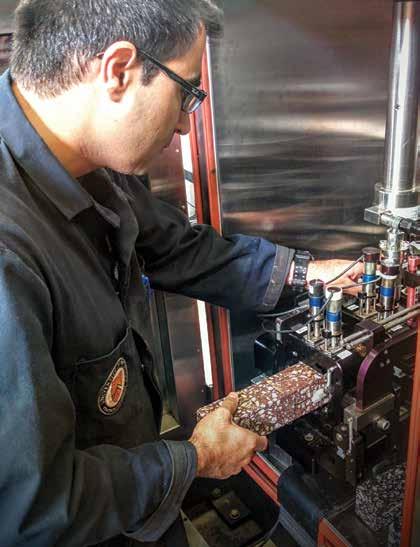
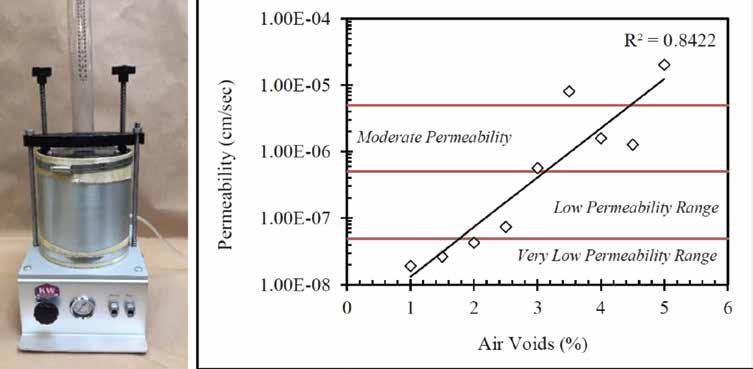
30 OAPC | ASPHALTOPICS
Figure 2. Karol-Warner Asphalt Permeameter (left) and laboratory permeability versus air voids measured for low permeability asphalt mixture (right).
Figure 1. Four-point bending beam setup used in testing long-term durability of asphalt mixtures under repeated cyclic fatigue at certain strain level and climate conditions.
However, two questions remained at the time and would be still applicable today for all balanced mix designs: 1) what temperature should be used for testing; and 2) what threshold should we target? My answer: It depends how well the mix is balanced for a particular application, and yes, it does take expert-level judgment in relating laboratory to field performance.

THE NEED FOR BALANCED MIX DESIGN AND PERFORMANCE TESTING PRESENTS A FORK-IN-THE-ROAD OPPORTUNITY FOR OUR INDUSTRY.
Balanced mix design offers a new and improved method for predicting and creating better longer-lasting roads. That is why industry partners need to come together to establish realistic testing conditions for Ontario through laboratory and field trials. An example would be Hamburg Wheel Track test — should we run the test at 50°C or lower? This question is difficult to answer without field verifications and validations through benchmarking exercises.
The literature and experience of other provinces and of our neighbouring friends in the U.S. could certainly provide greater insight, but we still need to verify with Ontario-specific climate and traffic conditions. A mix used for a low volume road in Northern Ontario and a mix tested for a heavily-loaded section of Highway 401 in southern Ontario cannot use the same testing temperature and expect to meet the same rutting thresholds. The same comparison applies to testing bridge deck mixes versus airfield mixes. These are different “beasts” of asphalt mix applications that attract their own unique “beauties,” and the same goes for balanced mix design and selection of performance tests. One sweep of Hamburg wheel, SCB, and DCT will not be applicable in balancing different “purposefully balanced” mixes.
Other items to consider are the air voids of performance testing samples. For typical roadway designs, 7.0% ± 0.5% air voids are considered representative of a minimum in-place density of 93.0% ± 0.5%. But for a low-permeability bridge deck mix, in-
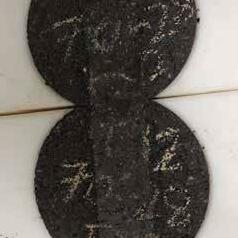
place density of higher than 96% is expected, and performance testing should be run at 4.0% ± 0.5% air voids.
ADDITIONAL TESTING STRATEGIES OFFER FLEXIBILITY TO MEET PRODUCTION DEADLINES.
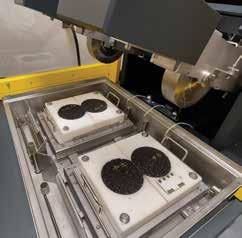
Another strategy to keep in mind is the use of surrogacy for different performance tests. Some tests like SCB or IDEAL CT tend to provide a quicker turnaround and can be more QC/ QA friendly. There is no problem in using these tests — they just need to be properly calibrated to the mix. This level of surrogacy offers a viable alternative when the time needed by tests like the four-point bending test would not meet production deadlines. Another way of performing QC or QA is simply keeping the asphalt binder content and aggregate close to the job mix formula (JMF) within the allowed tolerances. This option often doesn’t necessarily require performance testing on production samples.
A BMD or performance-based design still needs baby sitting through plant production and field implementation. A few plant trials should be incorporated into the work plan. It’s important to understand how closely a JMF can be replicated by the plant or different types of plants (batch versus drum). Plant trials create a safe cushion to determine if a mix performance will conform as closely as possible to its design-allowed tolerance. This tolerance can be derived from the design points considered in balancing the binder-aggregate ratio or established by running additional performance testing at the upper and lower bandwidth limits permitted on DLS and nonDLS sieves.
EXPERIENCE MATTERS. SO DOES CAREFUL SELECTION OF TESTING PARAMETERS AND THRESHOLDS.
My four years of experience with the bridge mix demonstrates the need for careful selection of testing parameters and thresholds. The same bridge mix idea was designed for more than ten bridges across southern Ontario and New Brunswick. The thresholds and balancing were not the same for all bridges.
FALL 2022 31
Figure 3. Hamburg Wheel Rut Tester to evaluate the stability of the aggregate skeleton and stiffness of the binder at certain temperatures while the sample is being submerged in hot water, indicating any moisture susceptibility concerns with the aggregate and binder compatibility. Also shown is the before and after of a mix tested by a Hamburg wheel.
››
Each bridge presented a unique condition. A few bridges in Ontario utilized orthotopic steel decks with epoxy-sprayed membrane solutions. Other bridges in New Brunswick employed a special bond coat applied on concrete prior to paving. All decks varied in age, in membrane conditions, and in traffic characteristics and climate conditions. Threshold and testing temperatures differed slightly and were tailored specifically to each bridge project. For example, a rutting temperature of 50°C was selected for higher traffic volume bridges with a threshold of less than 12.5 mm rut, but for an extended number of passes up to 40,000 passes, as opposed to the 20,000 passes currently under consideration for highways. This extended time was to simply capture instability beyond short-term (few first years) of field performance and further provide an insight into mix instability when saturated to a degree in hot water for prolonged conditions. This may not be the case for highways as much as for bridge mixes when only 60 mm or so of the mix is installed on fairly impervious substrate with or without membrane.
All bridges in our development cases were successfully paved and have been in service for more than four years as shown for one of the southern Ontario bridges in Figure 4 on page 28. However, one question remains: Would we have been able to design these specialty mixes with just volumetrics?
A similar concept briefly explained here has been used for other different applications across Ontario, including high shear-resistant and fuel-resistant airfield mixes for runways and taxiways, shove-resistant heavy-duty intersection mix, highly flexible overlay for badly deteriorated roads with no need for milling prior to paving, ultra-thin 4.75 mm NMAS mix placed directly on gravel, and more. We now have more tools in the toolbox of performance testing, and we should begin to use them. We need to begin gaining experience and sharing our findings on where the thresholds for these tests should be.
Risk taking is an absolute step that can be taken either by the mix designer, or contractor, or shared between them in a field trial and 5-year monitoring framework. But, putting it in plain words, if you do performance testing, your risk should be already minimized, so what do you have to lose compared to relying solely on volumetrics? Time would be the solution, as more projects like what I have experienced become part of our day-to-day and enable us to establish
following practical parameters for each performance test or so-called tool in our toolbox:
1. Test analysis complexity and relation to field performance;
2. Practicality for mix design, or QC/QA; and
3. Coefficient of variation for single or inter-laboratory scenarios.
GEN A-ASPHALT IS A NATURAL EVOLUTION, AND WE MUST EMBRACE IT OR BE LEFT BEHIND.

Beginning with the first mixing of asphalt with sand and pulverized carbonite lime back in 1890, up to the first implementation of Superpave in Ontario in the mid-1990s, the asphalt industry has recognized the need to evolve to meet changing environmental and traffic conditions. Why should we expect today to be any different? Even the transition of Marshall to Superpave seemed difficult at the time, but decades after, Superpave is our choice of design. We got together and got it done!
This is an important question for the current generation of adults who populate our industry. To quote the famous adage, we must “adapt or die.” Granted, it may sound extreme, but those who fail to move forward, who fail to at least investigate new technologies and new methods, risk becoming the dinosaurs of our industry.
The advent of Gen A-Asphalt should not be viewed as posing difficulties for contracts or in our day-to-day professional life. It’s an opportunity to meet today’s challenges head-on and create better performing, longerlasting pavements. Let’s move forward together from a Consultant-ContractorOwner (CCO) perspective, and let’s embrace performance testing and pave the way toward a proper, large-scale implementation of performance-tested, balanced mix design techniques — before we lose a generation of talent who become frustrated with our lack of forward momentum.
Sina Varamini, Ph.D., P.Eng., is Director, Pavements and Materials Group, at Engtec Consulting Inc. and Ontario Asphalt Expert Task Group (OAETG) chair.
32 OAPC | ASPHALTOPICS
2022ASPHALTTECHNICALSYMPOSIUM RECAP

The Asphalt Technical Symposium is a platform sponsored by OAPC to encourage and improve dialogue between stakeholders in Ontario’s asphalt industry with the following core objectives:
1. Provide a platform for unbiased technical discussion and sharing;
2. Educate each other on the specific elements of technology necessary to achieve high performing asphalt pavement including materials, design and construction practices;

3. Respectfully share different points of view and visions to improve asphalt pavement quality; and
4. Identify and develop a list of technical topics and agree on next steps to adequately address them.
This year’s symposium featured a summary of the Ontario Mix Asphalt Program (O-MAP) study, which was presented by Ontario Asphalt Expert Task Group (OAETG) chair, Sina Varamini. Varamini provided insights into the experimental study to understand potential variability in results if performance testing was implemented in Ontario based on existing methods. Mix samples were provided by two industry suppliers and testing focused on popular performance tests currently being explored in North America. The results of this study highlighted the challenges that may exist with the implementation of these tests without further investigation into a correlation of testing conditions to field performance.
The ATS next changed gears to talk about emerging approaches to RAP and high-RAP HMA mixes. The presentation was a shared approach to provide both a municipal perspective, presented by Trevor Tinney (Town of Innisfil), and an industry perspective, presented by Mike Aurilio (Yellowline Asphalt Products). This allowed the participants of the ATS to engage both parties on their comments from each perspective.
Tinney’s presentation provided insight into how the Town of Innisfil manages the use of RAP in their mixes today and how it is exploring future opportunities to increase this practice. Aurilio provided the group with industry perspectives into RAP usage including insights into ensuring the recycled material is properly understood before addition to the mix. He also highlighted the criteria that certain U.S. states use to help increase RAP usage effectively in their regions.
The last topic of the day was presented by Chris Campbell (Imperial Oil) on the AASHTO & ASTM revisions for G*sin δ (DSRp) implemented in July 2021. This topic focused on reviewing challenges identified with the existing G*sin δ (DSRp) specification, the investigation into trying to improve the test method variability, and the ultimate AASHTO-implemented recommendation of a phase angle limit for binders with G*sin δ between 5000 and 6000 kPa. Phase angle has been shown to be a better parameter for differentiating binder performance. Most Canadian provinces and U.S. states have adopted this change, leaving some areas that have not adopted it, like Ontario, at risk of requiring modification in order to meet older revisions of the standards.
More detail on these presentations can be found at onasphalt. org/Publications & Education
Having now successfully completed four symposiums, the ATS team look forward to reviewing feedback from this session as we set our sights on the next event in 2023. We hope that all who attended this year’s event found it informative and worthwhile, and enjoyed the technical presentations and discussions. If you have any questions about this event, please reach out to Doubra Ambaiowei.
Chris Campbell is Americas Asphalt Group & Technical Lead for Imperial Oil and ATS co-chair.
FALL 2022 33
Those who knew Brian Keveryga remember his kindness, exceptional technical know-how and quick laugh. They remember a knowledgeable industry expert, a mentor and dedicated volunteer, happy to help out wherever he was needed.
Larry McLean, Territory Manager GTA East for HMA Equipment Canada, met Brian when he started as an apprentice mechanic at a CAT dealer called Crothers. “I was a field tech with an eight year head start on Brian. One day I took him out into the field and I remember saying to the service manager when I got back that the kid had too many smarts to just be a mechanic.”
Brian remained at the dealership and worked his way up to the technical services department. That was where his ability to talk to people on a technical level really came to light and was a gift he had his entire working career. He was highly technical, but could talk to anyone at any level about the subject at hand.
Caterpillar purchased Barber Green in 1991. When the first CAT pavers hit the Ontario market, there was a lot of attention needed to get the crews to accept them. Brian would stay with the crews day and night until they were happy, and worked closely with the CAT factory paving division to make the necessary improvements. He did this for 20 years until he had a 90 per cent market share in Ontario.
In 2002, Brian took over the new paving equipment department at Toromont CAT which he was instrumental in creating. Six years later, he started a crushing department, managing both departments simultaneously. He developed relationships in Ontario and throughout the world, becoming highly respected by the customer base and both manufacturers and suppliers. “Brian had no enemies. Whatever the situation, he always dealt with it in a factual way and could walk away everyone’s friend at the end of the day. That was a gift he had as well,” says McLean.
Fernando Magisano, Senior Technical Advisor at Canadian Asphalt Industries Inc. and a customer of Brian’s for 20 years, agrees. “I can’t think of one person who had nasty word to say about hm. You just couldn’t find a nicer guy. He always had a smile on his face no matter how busy or tired he was, and if he could accommodate you, he would. I can’t say how many times I saw him in the dark helping crews at night. If there was a problem, he would be out there.”
“Brian was just a great guy. Every owner, manager and paving foreman had his number and he was never too busy to take a call. He would stay at a job or on the phone until he knew the problem was resolved,” says Malcolm Croskery, Chief Operations Officer, Pioneer Construction Inc.
Daulta O’Hanlon, District Sales Manager at Wirtgen Group, met Brian in 2009. “I was a mechanic at Toromont and trained

on how to rebuild and adjust asphalt screeds. I was called out to a machine that he was having problems with to help him wrench on the screed to get it back into tolerance. I left the jobsite at 10 p.m. Brian stayed till 5 a.m. and took a hotel locally to see the job through. A year later Brian invited me to be his paving specialist and I took the job.”
“Brian was my mentor,” continues O’Hanlon. “I was a great technician, but I needed a lot of work to become a good paving specialist. Brian had patience and spent a lot of time with me. He introduced me to OHMPA and ORBA where I would watch him at events talking with some of the top leaders in our industry. No one else was getting this kind of attention from major leaders. That’s when I knew there was something special here.”
Numerous people in the industry can count Brian as their mentor, coach and teacher over the decades. The word is that he was responsible for training most of the Ontario crews on how to be great at paving one coffee at a time. He often joked that he had the largest coffee expense account in the company. “You couldn’t find a better person to teach,” says Magisano. “He could speak to QA people and he could speak to what equipment was doing with quality and compaction. He could teach it well at the base level and then could ramp it up to the nuts and bolts and everything in between depending on whom the audience was going to be. He would volunteer to spend half days or more with the crews, doing presentations and training. And he was there every year we asked him.”
Magisano continues: “I remember in about 2010, we had some new members on key paving crews at Beamish and wanted to do a paving 101 course. I called Brian and asked if he could put together a one-day training session for all our crews. Brian suggested that we should bring a paver or two into our King City yard and some sand to load and put through the pavers to show how the controls for the screed worked without wasting actual hot mix. Then he brought this idea up at OHMPA’s Plant & Paving Committee and asked if they wanted to piggy back on the training and have a pave-in demonstration at Beamish as part of the Spring Operations Seminar that year. So we did and Brian organized most of it.
34 OAPC | ASPHALTOPICS
Admit when you were wrong. Admit when you do not know the answer. They will understand.
BRIAN KEVERYGA to DAULTA O’HANLON
“Just before the pave-in, Brian found out that Dufferin had a paver installed with infrared heaters. He talked them into bringing the paver in for the pave-in so we could demonstrate how it worked. He was the one who would make the phone calls and could get contractors to move heaven and earth. He was like that his entire career, even when he was running a company. It says asphalt specialist on my phone contact list for Brian’s title — I never knew his formal title, but that’s what he was.”
Brian was an enthusiastic industry volunteer and long-time supporter of OHMPA/OAPC, sitting on committees and presenting at and sponsoring events such as Spring Ops, the golf tournament, and the Fall Asphalt Seminar. Mike Deckert, Vice-President at FLO Components Ltd., knew Brian for about 20 years. “I started on the Plant & Paving Committee around 2004/2005, and Brian had been on it a year or two longer. He could always be counted on to help organize and support our initiatives.
“He and I also sat on Program Advisory Committee (PAC) for Conestoga College,” Deckert continues. “Each college has a PAC which is a mix of industry professionals, instructors, the college dean and chair. We are responsible for making sure programs are current, and in our case specifically the heavy duty operator and technician programs. He also promoted our Roads Scholarships and made presentations to the winners.”
In 2009, Brian was awarded OHMPA/OAPC’s Earl Kee Volunteer of the Year Award. The award recognizes a member of OHMPA/OAPC who has demonstrated outstanding service to the organization and made an exemplary voluntary contribution to its work. The spring 2010 awards issue of ASPHALTopics noted that “Brian has been a strong, consistent and valued supporter of OHMPA events and a leader of the training and plant and paving committees.”
After two decades with Toromont CAT, Brian saw an opportunity and started HMA (Hot Mix Aggregate) Equipment Canada Ltd. in 2012, which he ran successfully until his death. Brian’s unexpected departure from the helm of HMA has understandably left an enormous hole, but Larry McLean and the rest of the HMA employees are working hard to keep up Brian’s dedication to his customers.
“I didn’t replace Brian — he was my friend and he is irreplaceable. I am simply stepping in and guiding the ship for the next period of time while we do everything we can to maintain the successful relationships with our customers that Brian started,” says McLean.
“I think Brian’s biggest contribution to the industry was his ability to develop and maintain a large resource base of connections. For some people he was coach and mentor; for some a leader. It all went back to being technically sound at what he did in the asphalt business. He understood the business from beginning to end and inside out,” says McLean.

Brian left his mark not only on the road-building industry, but also on all those who knew and worked with him over the years. He will be remembered.
Brian Keveryga died suddenly on March 14, 2022 in his 55th year. He leaves his wife, Katherine, and children Courtland, Makenna and Kaleb.

 by Lara Henry
by Lara Henry
One of the biggest tributes to a person is when you can mention their name in an industry and people know them or have a story about them. That was Brian and it goes to who he was as an individual.
FALL 2022 35
MIKE DECKERT
Lara Henry is a communication specialist and editor of ASPHALTopics.
The P-404 fuel-resistant asphalt mix was 50 mm thick after compaction. The GTAA hopes these surfaces will perform well for 10 years or more. (McAsphalt)
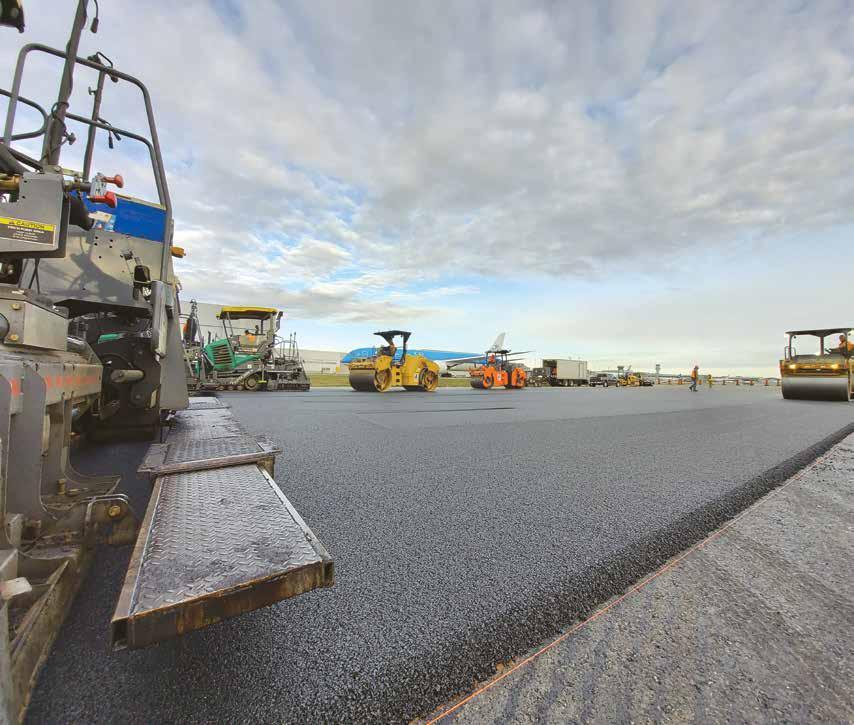
36 OAPC | ASPHALTOPICS
First-in-Canada innovative airfield mix at Pearson holding up well
The spring 2021 issue of ASPHALTopics featured a first-in-Canada airfield mix field trial at the Greater Toronto Airports Authority (GTAA). For this trial, a uniquely developed mix was laid down at the Pearson International Airport’s Taxiway Bravo in October 2020. The specific formulation of the binder supplied by McAsphalt Industries created a PG 82-28 Fuel Resistant (FR) grade which was used to design a mix design as per guidelines provided by the Federal Aviation Administration in the United States.
The official name of this fuel-resistant asphalt mix, which has been approved by the Federal Aviation Administration, is FAA AC150/5370-10H Item P-404 Fuel-Resistant Asphalt Mix Pavement (P-404). The FAA’s approval, plus the positive results with P-404 experienced by Logan and other U.S. airports, has led to interest in this mix in Canada for those airports confronted by a dilemma when it comes to paving their runways and taxiways.
Asphalt pavement is the quickest and least expensive of their two surfacing options, but aviation gasoline (AVGAS) leaking from airplanes and fuel trucks can dissolve asphalt binders — resulting in rutting, shoving, and premature surface deterioration. While the option of concrete pavement doesn’t suffer from the same problem, the high cost and additional hours required to apply this surface leads to expensive downtimes and traffic disruptions of the airports.
Seeking to achieve a ‘best of both worlds’ solution for this problem, airports such as Boston’s Logan International have laid down a polymer-enhanced, fuel-resistant asphalt on their paved surfaces with considerable success. They achieve the economy and speed of conventional asphalt paving while attaining the resistance to jet fuel erosion.
Initial work on the binder development dates back to early winter 2017, when Associated Asphalt’s fifteen-plus years of international experience with this type of binder/mix was shared with McAsphalt Industries Limited for a local production feasibility study. The FR binder required a uniquely formulated binder for the extreme stresses that airport pavements must endure, namely exposure to jet fuel and the enormous weight of slow-moving aircraft. This FR binder was formulated using engineered polymers and speciality additives to increase the mix resistance to heavy loads combined with fuel-induced failure modes. The lubricity of the binder is also balanced using special additives to achieve lowered design air voids of 2.5 per cent despite the significantly high 82-28 PG grade. This allowed the creation of a mix that was less permeable and thus more resistant to fuel and de-icing ingress.
The precise blend of the binder and aggregate was created as per FAA guidelines which brought its own challenges. The aggregate size variances between the mixes were small. The FAA P-404 spec called for a very fine graded mix, with 95 to ››
FALL 2022 37
100 per cent passing a 9.5 mm sieve and about 60 per cent passing a 4.75 mm sieve. The asphalt cement content was relatively high as well, ranging from 6.5 to 7 per cent. So this was a very unique mix in terms of design and ensuring that there were no issues with bleeding and excessive rutting. The mixes were designed and the performance tested at SNC Lavalin Material Testing and Research laboratory in Vaughan, Ontario. After nearly 6 months of mix design work, a recipe was created and approved for field trial at Taxiway Bravo.
LAYING DOWN THE MIX
The paving of Pearson’s Taxiway Bravo took place over two days in October 2020. The paving itself was done by Dufferin Construction Company/CRH Canada Group. On October 13, a test strip at Taxiway Bravo was placed to ensure adequate density could be achieved, and to get the crew familiar with the mix (Figure 1). Roughly two live bottom loads, or about 50 tonnes, were placed. The next day, 450 tonnes of the P-404 HMA was placed in the location shown in Figure 1. The existing asphalt surface had been milled down to the top of the original concrete taxiway. A 65 mm (compacted depth) of PG 64-28 base course was placed first followed by the P-404 surface course, which was 50 mm thick after being compacted. The experience gained through the 2020 Taxiway Bravo trial was used in paving Taxiway Alpha in the summer of 2021 for the same tonnage and pavement structure make-up.

RESULTS TO DATE
Figure 2. Two year follow-up images of Taxiway Bravo paved with P-404 mix.





It has been over two years since Pearson’s Taxiway Bravo was paved and over a year for Taxiway Alpha. Everything has gone well as shown in Figures 2 and 3, and the P-404 is standing up to everything the aircraft can throw at it, including fuel spills. The fine texture has not caused any issues with the surface with regular use.
Figure 3. One year follow-up images of Taxiway Alpha paved with P-404 mix.
Overall, this implementation demonstrates that innovation needs champions and sponsors to push new ideas, no matter how complex the project is or how much is at stake.
Looking ahead, the GTAA is hoping that P-404 HMA-paved surfaces will perform well for 10 years or more, as they have at Logan International Airport. The two-year P-404 field trial should help the GTAA assess whether this is a realistic expectation in a cold Canadian climate. That said, the substantial reduction in Pearson aircraft traffic during the COVID-19 pandemic may affect these results.
This article first appeared in the spring 2021 issue of ASPHALTopics, and has been condensed and updated by Mohammad Ahmed, P.Eng., Manager, Quality Assurance, SNCLavalin, Environment & Geoscience Infrastructure); Kevin Chee, P.Eng., Senior Engineer (Airside Civil), Greater Toronto Airports Authority; and Sina Varamini, Ph.D., P.Eng., Director, Pavements and Materials Group, Engtec Consulting Inc.

38 OAPC | ASPHALTOPICS
Figure 1. Location of first trials at Taxiway Bravo in October 2020.
UNSUNG HEROES
by Steve Pecar
Extensive experience helps Pahalan prepare for the future
Andrew Pahalan
s laboratory manager at Engtec Consulting Inc., Andrew Pahalan gets to meet the daily challenges of the asphalt paving industry head on. Working on advancements in pavement technology, meeting with clients and long-time colleagues on a regular basis, and solving problems is a motivation that he thrives on. And, after 25 years in the business, he is keen to keep his eye on the future and looks forward to what the industry has in store.
“This is a great career, one that I have been proud to be a part of since the beginning,” Pahalan says. “When you have a career that you enjoy, you look forward to going to work each day and being part of something.”
Pahalan started in the industry while he was still in school studying civil engineering when he applied for a co-op position at Ashwarren Engineering to work in the asphalt lab. From there, he moved to Warren Bitulithic Limited where he worked as a quality control co-ordinator on highway projects.
“I gained a lot of experience doing that, especially on several of the 400 series highways,” Pahalan says. “There were many people I learned from, people who were always willing to share their knowledge and expertise. I’m so appreciative to have learned from those who know so much about this industry and who mentored me in my early career, and very fortunate to have worked with professionals like Steve Smith, Paul Lum, Mike Greco, Carlo Fallavolita, Domenic Passalacqua and George Aggio, to name a few.”
Soon Pahalan became manager of the Quality Control Division while the company changed hands — first to Lafarge and then Coco Paving. Along the way his duties expanded to include looking after asphalt and aggregates operations for several divisions within the company. It was a lot of work that included plenty of traveling, but Pahalan says it was an exciting time.
“I was very hands on at the plants from dealing with personnel to creating the mixes to being in charge of quality control and the paving projects,” Pahalan says. “On any given day, I could be almost anywhere in Ontario. It was amazing meeting and working with so many people, people who I could learn from and then be able to put that knowledge into practice. It was great to be a part of that.”
By 2017, Pahalan had joined Engtec as a partner and continues with his current duties as head of the lab.

Salman Bhutta, who started Engtec, says Pahalan has brought years of experience to the company and his skills are ones that are admired and appreciated throughout the industry. This has allowed the company to grow as clients trust his leadership and judgement.
“The work he does is pretty extensive,” says Bhutta. “Anything that has to do with material testing and quality control falls under his duties. He is considered an expert and so many companies have come to rely on his expertise. An asset like this in this industry can be very difficult to find so we are glad that he is with us.”
As for the future, Pahalan says he has set his sights on helping the company grow from its current 80 employees and expand across the country. As well, he says he would like to encourage new people to enter the field and assist with the training of young people to replace those in the industry that are retiring. “There is so much opportunity out there right now for people to enter this business, and so many roles to fill,” Pahalan says. “I would like to be a part of showing people what this field is all about and launching new careers to help to fill the needs of the industry.”
Steve Pecar is a Mississauga-based writer, editor and designer.
FALL 2022 39
TECHNICALLY SPEAKING
Dr. Pejoohan Tavassoti
Opportunities to advance the sustainability of asphalt pavements

Improving the long-term performance of pavements has always been a common goal of the different stakeholders in the transportation sector. The tools and methodologies used to achieve this goal may differ from one jurisdiction to another, and they certainly have evolved over time with the advancement of technology and our knowledge of pavement materials. Nevertheless, the majority of these efforts have been focused on preventing major durability issues in flexible pavements, namely fatigue cracking, rutting, low temperature cracking, and moisture-induced damages. These four “performance” considerations remain relevant regardless of the changes in mix designs, construction practices, climatic conditions, and the nature of paving materials.
For a long period of time, mostly empirical methods and volumetric properties of mixes were considered a viable means of designing asphalt mixes to meet durability requirements. Nowadays, techniques which were perceived as highly sophisticated testing and evaluation in the past have become very affordable, practical, and accessible. Availability of such test methods that can somehow mimic the performance of asphalt mixes has created an opportunity to design and produce more sustainable pavements to withstand the adverse impacts of the changing climate and increased traffic loading while allowing for using new sources of materials. In other words, this creates opportunities for innovation in paving
materials and high-performance mixes which was not possible through solely relying on volumetric mix design. More specifically, these capabilities can aid us in making the most of valuable sources of recycled materials such as reclaimed asphalt pavements (RAP) or other viable options such as crumb rubber, polymers, processed waste plastics, etc. The bottom-line, in any case, should be meeting or exceeding the long-term performance of conventional mixes. Looking at the international experiences, this can be successfully achieved through a systematic approach that is supported by evidence-based decisions and accounting for domestic conditions. Figure 1 illustrates a conceptual summary of the steps that need to be considered for this purpose and before full implementation.
While the choice of specific tests to be used in this regard is important, it has been discussed extensively elsewhere and is not the focus of this article. A promising set of tests can be picked based on the past experiences, which now spans to more than two decades of data. However, what mainly contributes to a successful adoption of this new approach would be a wellthought implementation plan, establishing proper thresholds that are representative of the dominant domestic conditions, and revisiting the results and fine-tuning the specifications as we progress. This requires the use of our collective knowledge and close collaboration of the different stakeholders.
40 OAPC | ASPHALTOPICS
Although optimizing the usage of recycled materials was historically the main driver for balanced mix design and performance-engineered pavements, this concept is not by any means limited to RAPincorporated mixes and is applicable to designing any type of mix with the goal of improved durability. Benefiting from both empiricism and scientific principles, this approach has also provided the possibility of developing speciality mixes for certain applications where the conventional mixes do not measure up to the requirements. While the concept of designing for performance is versatile, conducting benchmarking studies using the domestically available materials and climatic conditions is an essential step toward its success. To this end, it is crucial to study the impacts of the mix constituents when establishing thresholds for mix design and QC/QA activities. In other words, implications of using different aggregate sources or gradations, asphalt binder types and grades, recycled materials, additives, and mix production details on performance metrics should be well understood. This helps eliminate the bias effects when interpreting the performance of different mixes ››
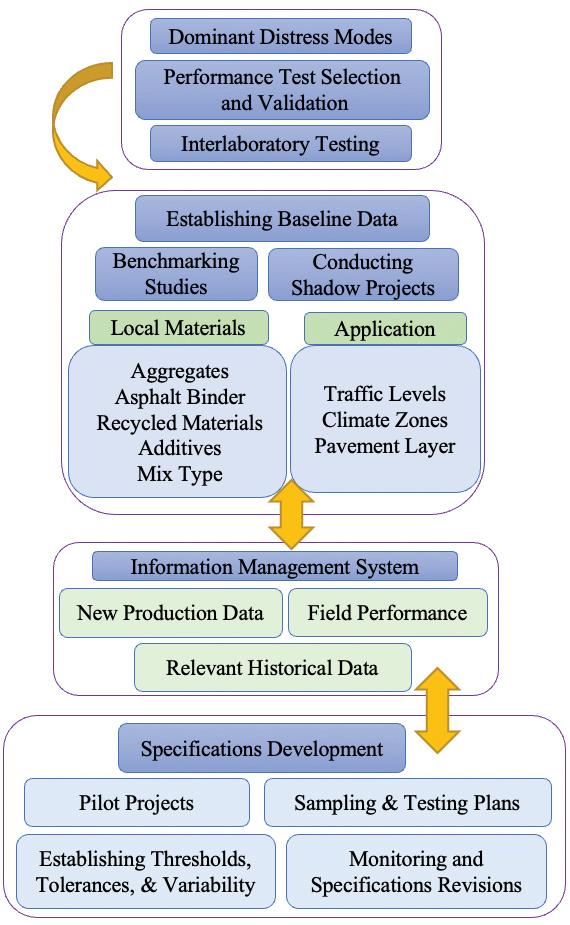


15 AME www.aecon.com 04 AGGRESSOR www.aggressorautomation.com 08 ASTEC INC. www.astecinc.com 45 BLACKHAWK COMBUSTION www.blackhawkcombustion.com 25 CCIL www.ccil.com 51 CANADIAN ASPHALT www.canadianasphalt.ca 06 ENGTEC www.engtec.ca 03 FLO COMPONENTS www.flocomponents.com 47 GENCOR INDUSTRIES www.gencor.com 32 HOSKIN SCIENTIFIC www.hoskin.ca 21 LIUNA www.liunaopdc.ca 20 M&L TESTING www.mltest.com 52 McASPHALT www.mcasphalt.com 12 TROXLER CANADA www.troxler.ca 02 WIRTGEN www.wirtgen-group.com 42 YELLOWLINE www.yellowline.ca Figure 1. Overview of components of performance-based design approach.
and reduces the risk to the stakeholders. Evaluating the experimental conditions such as testing temperatures, passing/failing criteria, bias and precision statements, and variability of the test results is another important consideration that can be done through round-robin or interlaboratory testing.
As in any other endeavours, knowledge is the key to success. An effective information management system that can build on relevant historical data, new production data, and actual field performance would be instrumental to make the most of a performance-based approach. This will facilitate establishing a relationship between the test results from lab-produced and plant-produced mixes, as well as the results from testing to their corresponding field performances. Finally, relevant specifications can be developed detailing the sampling and testing plans, tolerances, and potential pay adjustment factors. Learning from experiences in other jurisdictions, this process will need to be actively monitored, especially at the beginning, and the necessary changes should be made to improve the specifications with time.
Moving forward, we can agree that relying solely on volumetric mix design can no longer accommodate the performance expectations from paving materials. Therefore, moving

towards performance-engineered mixes and pavements is not only necessary to allow optimal usage of recycled materials such as RAP, but also is a necessity in the face of our rapidly changing climatic conditions and emergence of new materials. The good news is that there are now several proven practices of using modern approaches to improve the resilience and sustainability of pavements. If implemented properly, these practices can have a multitude of positive impacts including improving the durability of pavements, supporting the responsible use of recycled materials, decelerating the depletion of natural resources such as aggregates, freeing up the limited landfill space in terms of construction waste management, reducing the environmental emissions, and helping with the economy of the pavement construction projects. This is a pressing matter that should be addressed with due diligence through taking preplanned systematic actions .
Dr. Pejoohan Tavassoti is Assistant Professor of Civil Engineering and Jr. Norman W. McLeod Chair in Sustainable Pavement Engineering, University of Waterloo, and vice chair of the Ontario Asphalt Expert Task Group (OAETG).
42 OAPC | ASPHALTOPICS
TECHNICAL AND SAFETY COURSES LEAD THE WAY FOR THE 2023 ORBA ROAD BUILDING ACADEMY
TECHNICAL AND SAFETY COURSES LEAD THE WAY FOR THE 2023 ORBA ROAD BUILDING ACADEMY
by John Provenzano
Lifelong learning is an indispensable tool for every career including the road-building industry. Continuing education forms a necessary part in acquiring critical thinking skills. It forms part of your personal and professional development to expand your skill set and help you reach your full potential. Through the Road Building Academy knowledge is now at everyone’s fingertips. That’s why the Road Building Academy has become such an essential educational program for ORBA members.
The Road Building Academy brings world-class instructors and courses from across North America to Ontario, and features ten technical and safety courses including:
• Fundamentals of Asphalt Plant Operations;
• Practical Solutions in Hot Mix Technology 2.0;
• Practical Solutions in Managing Excess Soil;
• Sustainable Asphalt Pavements;
• A Day in the Life: Developing the Next Generation of Forepersons, Superintendents, & Project Managers;
• Geotechnical Engineering - A Review of the Fundamentals;
• Introduction to Design of Roadway Protection Systems and Cofferdams;
• Occupational Health & Safety – The Next Level;
• Ontario Traffic Manual Book 7 & Traffic Management –For Road Builders by Road Builders; and
• Project Planning & Estimating Techniques.
Other Academy courses cover management, leadership, business practice, and legal topics.

The Road Building Academy will once again offer a certificate in Project Management I and Project Management II in conjunction with the University of Waterloo. The curriculum is compatible with the project management industry standard set by the Project Management Institute (PMI) and courses qualify for Professional Developments Units (PDUs)/Contact Hours.
As an employer, providing support for continuing education shows employees that you see their value. This, in turn, effectively improves employee retention, which helps reduce expenses caused by employee turnover. Employees will feel more valued and motivated
to expand their skills in different areas. A culture of ongoing learning benefits both current employees and recent hires, as well as attracting potential employees.
Companies considering registering their employees for Road Building Academy courses are encouraged to take advantage of the CanadaOntario Job Grants Program, which gives direct financial support for employee training. All ORBA Road Building Academy courses are eligible for funding.

About the Canada-Ontario Job Grant Program
The Canada-Ontario Job Grant (COJG) provides opportunities for employers, individually or in groups, to invest in their workforce, with help from the government. The COJG provides direct financial support to individual employers or employer consortia who wish to purchase training for their employees. It is available to small, medium and large businesses with a plan to deliver short-term training to existing and new employees.
Employers can receive up to $10,000 in government support per person for training costs. The training has to be delivered by an eligible, third-party trainer. Employers with 100 or more employees need to contribute half of the training costs. Small employers with less than 100 employees need to contribute one-sixth of training costs.
Currently the ministry is only accepting training applications for 25 or less participants. Employers interested in accessing funding to support training and/or workforce development needs are encouraged to submit applications for Skills Development Fund (SDF).
For employer groups who want to apply for training support, the government offers a COJG Consortium Stream. The Consortium Stream allows a group of employers (two or more employers) to pool their resources to support common training objectives and goals. To apply as a consortium, the intermediary organization needs to ensure all the participating employers and trainees meet COJG requirements, and are able to make their required contribution towards the training cost.
To learn more about the COJG visit their website at http://www.tcu. gov.on.ca/eng/eopg/cojg/
FALL 2022 43
ENVIRONMENTAL ESSENTIALS
Dr. Jessica C. Achebe

Environmental sustainability in context for Canadian roads
The Government of Canada declared a goal to reduce GHG emissions by 30 per cent below 2005 levels by 2030 at the Conference of the Parties (COP) 21 under the United Nations Framework Convention on Climate Change (UNFCCC) 2015 Paris Agreement. This declaration put action on climate change atop the Federal Sustainable Development Strategy. Environment and Climate Change Canada developed the Canadian Environmental Sustainability Indicators (CESI) program to report on the current state of the environment and track progress of the Federal Sustainable Development Strategy.
The CESI program provides a framework to identify the main factors of focus for quantifying pavement environmental sustainability performance in Canada. However, the Federal Government in Canada typically legislates transboundary aspects and issues. The regulation of environmental protection largely falls to provinces and territories, each having its own legislation with respect to environmental factors of concern and priority. Moreover, highways and road networks in Canada generally fall within the purview of provincial/territorial jurisdictions. Exceptions include the highways through national parks and a portion of the Alaska Highway, which are managed by federal departments and agencies. Therefore, the planning, design, construction, operation, maintenance and financing of highways are the responsibilities of provincial/territorial governments within their jurisdiction.
Effective analytical inclusion of environmental impacts in pavement management decisions are thus highly dependent on:
1. The values of the province or territory and its road authorities;
2. How these values are prioritized; and 3. The plan to operationalize those values and prioritize them.
In Ontario, the Ministry of Transportation (MTO) has established its Statement of Environmental Values (SEV) in response to the provincial Environmental Bill of Rights (EBR). The EBR is based on three principles: 1) valuing the natural environment, 2) the right to a healthy environment, and 3) environmental protection. One of MTO’s SEV priorities is “to integrate environmental concerns into decision making.” The MTOstated hierarchy of environmental protection, in order of decreasing preference is avoidance/prevention, control/ mitigation, and compensation/enhancement.
MTO has made efforts to establish procedures for mitigating impacts on the environment. These documents include:
• Environmental Protection Requirements (EPRs): These are a list of statements that provide a clear and organized list of environmental legislative and policy requirements. The EPRs are a synthesis of
44 OAPC | ASPHALTOPICS
the requirements in over sixty statutes, supporting regulations and formal government policies applicable to environmental aspects of transportation projects. For example, each statement of the Environmental Protection Requirements for Transportation Planning and Highway Design, Construction, Operation and Maintenance is an interpretation of these requirements as they apply to transportation planning and highway design, construction, operation and maintenance activities.

• MTO’s Class EA Document: This is an approved planning document that defines groups of projects and activities and the environmental assessment (EA) processes which MTO commits to following for each of these undertakings. The Environmental Assessment Act provides for the preparation at Class Environmental Assessments (Class EA). The Class EA is a principle-based document which defines the groups of projects, what must be achieved, and the processes that could be followed. Four main stages of focus in the Class EA process are - planning, preliminary design, detail design and construction.
• The Environmental Standards and User Guides: These contain an overview of significant environmental impacts associated with transportation projects for each environmental factor, design considerations in managing those impacts, and a list of applicable policies, guides, and references.
Other documents include environmental references such as the Environmental Reference for Highway Design (ERD) and Environmental Guide for Fish and Fish Habitat. The ERD addresses environmental assessment issues relating to preliminary design and detailed design of transportation projects. The Environmental Guide documents environmental assessment and mitigation processes and technical details for individual environmental factors as may be applicable on a projectspecific basis. In transportation projects, the environmental factors addressed depend on the project objective and study area conditions.
In Ontario, MTO has developed its own pavement sustainability rating tool called GreenPave. Like other available sustainability-rating tools, GreenPave is valuable as it encourages incorporation of environmental sustainability principles into infrastructure projects and suggests best practices on sustainability
improvements such as encouraging innovations, and use of recycled material. GreenPave is a credits-based rating system which assesses projects based on environmental criteria in four categories: Pavement Technologies, Energy & Atmosphere, Materials & Resources, and Innovation & Design Process.
Supporting sustainable pavement management more broadly would include, for example, expanding beyond environmental sustainability, capturing interactions among indicators, including long-term effects, and relating indicators to the goals, influence, and interactions of actors within a pavement management organization and across its stakeholders.
The understanding of these processes, tools and resources are integral to implementing and evaluating the environmental sustainability of pavements across their lifecycle within both the Canadian and Ontario context.
Dr. Achebe consults for the World Bank Group and is a post doctoral fellow and research engineer at McMaster University. Her areas of interest are in green infrastructure and urban sustainability.
FALL 2022 45
by Doubra Ambaiowei
OAPC’s commentary on environmental sustainability in context for Canadian roads

The Environmental Essentials column provides a good overview of the environmental framework and considerations for roads in Ontario. As an industry, it is important that we work to be more sustainable by optimizing existing processes for measurable and quantifiable energy usage. OAPC is working on:
1. Developing an action plan for a net-zero emissions strategy that could be implemented industry-wide over the next 10 years;
2. Continuing education on the benefits of RAP utilization;
3. Refining the Trillium Award Program;
4. Engaging and developing Environmental Product Declarations (EPDs); and
5. Understanding the impact of asphalt production facilities especially in the area of existing burner technologies.
Continuing consultations on MTO’s GreenPave Rating System requires that the asphalt industry provides any additional supporting documents on quantifying the energy savings from Reduced Energy Consumption, Greenhouse Gas Emissions Reduction, and supporting information to improve current ratings in the areas of Innovation/New Technologies. Consequently, new industry research studies are being encouraged.
Compared to Canada, the U.S. is more advanced with the implementation and application of EPDs. In addition, recently the Biden-Harris administration passed the Buy Clean Initiative and DOT’s first Buy Clean Policy Statement which focuses on expanding markets for clean manufacturing and using low carbon materials across the nation’s buildings and transportation infrastructure. The Asphalt Institute
(AI) has laid the groundwork to develop an EPD program for asphalt binder by forming an AI member-only EPD task force and will continue to monitor the progress of the Buy Clean Act. OAPC is also keeping abreast of developments through its partnership with the FHWA-Sustainable Pavements Technical Working Group (SPTWG).
Moving forward, we are looking for industry and municipal stakeholder responses to the following questions to guide our discussions and determine the type of assistance to solicit on advancing the use of EPDs for asphalt in Ontario:
1. What is your organization doing as related to the use of EPDs?
2. What is working regarding the use of EPDs? What do you like?
3. Is there anything that, in your organization’s opinion, is missing from other jurisdictional current practices regarding EPD usage that is needed or requires updating?
4. What is not working with EPDs? Where are you having major issues and what challenges do you have?
5. What is needed to address some of these challenges and concerns to facilitate usage of EPDs?
6. What specifically should ORBA/OAPC do to help advance the use of EPDs in Ontario?
7. Is there anything else you would like us to know, be aware of, or add related to EPDs?
Please communicate your feedback to me at Doubra.Ambaiowei@orba.org. We thank you in advance for your submissions.
46 OAPC | ASPHALTOPICS

2022 OAPC ASPHALT TECHNICAL
SYMPOSIUM
Thank you to all who made this year’s OAPC Asphalt Technical Symposium a success. It truly prides us to see the dedication of everyone in the asphalt industry. This year’s symposium explored our continuing focus on asphalt binder challenges, solutions, and pathways to mix performance testing in Ontario. It also covered the Ontario Mix Asphalt Program (O-MAP) study findings and next steps, emerging approaches to RAP usage, and education on PGAC supply implications. Presentations can be found at onasphalt.org/Publications & Education.
Lastly, we would like to thank our 2022 sponsors!

PRESENTING SPONSOR SESSIONS SPONSORS
ORBA WEBINARS



THE CANADA-ONTARIO JOB GRANT (COJG) PROCESS
ORBA is committed to developing talent in the Ontario transportation industry. That is why we put on the ORBA Road Building Academy each year. A significant part of our initiative is ensuring that organizations receive the funding they need to help their employees further their skills. We invited Kanchan Lakhotia, a COJG application consultant, to walk members through the process. This webinar gave our members the clear guidelines and process they need to follow to secure funding from the Canada-Ontario Job Grant. We invite anyone interested in continuing education to look at the presentation slides at orba.org/webinars
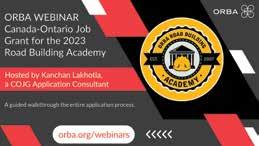
NAVIGATING NALOXONE KITS
The opioid crisis is a critical challenge for the construction industry, and job sites have been mandated to carry Naloxone kits. To help navigate everything related to Naloxone, we invited Mark Barnes, a pharmacist and owner of Respect Rx Pharmacies, to provide a presentation on navigating Naloxone kits. The presentation outlined the most recent drug use trends seen locally and described how a bystander can properly recognize behaviours that place someone at high risk of a drug overdose and why. It introduced nasal Naloxone as an overdose antidote, discussed how to identify an opioid overdose quickly, and concluded with proper naloxone training and Q&A. This was one of our best-attended webinars, and we encourage everyone to watch the recording at orba.org/webinars
48 OAPC | ASPHALTOPICS
OAPC 2022 FALL ASPHALT SEMINAR – DECEMBER 1, 2022

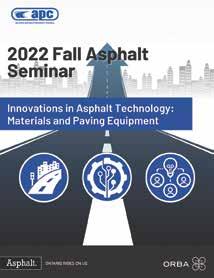
OAPC’s Fall Asphalt Seminar, Innovations in Asphalt Technology: Materials and Paving Equipment, focuses on information sharing and discussions that support our continuing quest for innovation and in realizing the highest-quality asphalt products. The agenda is loaded, and the in-person experience, our first since the pandemic, is not one to be missed.
Join us on December 1 by emailing Jasvinder Singh at Jasvinder.singh@orba.ca.
Thank you
TO THE 2022 OAPC FALL ASPHALT SEMINAR SPONSORS

PLATINUM
SILVER
SIXTH ANNUAL MUNICIPAL PAVING AWARD
The Municipal Pavement Awards recognize successful municipalprivate sector collaborations in hot mix asphalt road construction in Ontario. All hot mix paving projects completed between January 1, 2022 and November 30, 2022 are eligible.

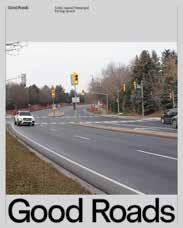
To nominate a project, complete the application form at goodroads. ca/awards by DECEMBER 23, 2022
BRONZE
OAPC FALL ASPHALT SEMINAR
DECEMBER 1, 2022
ORBA CONVENTION
FEBRUARY 5 TO 7, 2023
ORBA ROAD BUILDING ACADEMY FEBRUARY 27 TO MARCH 3, 2023
AMO 2022 AGM & CONFERENCE
We were thrilled to be a part of this year’s Association of Municipalities Ontario conference from August 14 to 17 where the Ontario government reaffirmed its dedication to building the transportation infrastructure that Ontarians need. The conference brought together over 2,300 municipal leaders, government officials, public servants, and industry partners to discuss a wide range of public policies, and there were an array of speakers, workshop sessions and diverse voices to hear from. We already look forward to being back next year!

FALL 2022 49
THE LAST WORD
Tom Dziedziejko
Change is the only constant
“I’ve been doing it this way for over 25 years with no problems.” How often have you heard this when discussing quality issues or specifications. The comment is intended to show experience, but when looking at the asphalt industry in Ontario, it may not.
Having retired from full time work, I can now look back at my 40-plus years in the construction and engineering industry. After working my way from technician to technical management for geotechnical and pavement engineering companies across Canada, I spent the last 26 years with Aecon where I started and managed Aecon Materials Engineering and then became Director Quality, Infrastructure. During this period, the changes we’ve seen in the hot mix industry in Ontario brings credence to the saying that the only thing that is constant is change.
In the 70s and 80s, highway construction was directed by MTO (then MTC). The ministry developed mix designs and production was controlled by ministry staff. If the contractor followed the specifications and made plant adjustments as directed by the ministry, the contractor was paid and moved on.
Circa 1989, MTO made the contractor more accountable for project quality. Contractors were made responsible for mix designs and control of their mix production. ERS was implemented including penalties and bonus. The change spurred contractors into developing internal quality expertise to limit penalties and optimize bonus payments through best quality practices. Bonus has not been available on MTO projects since 2017 for mix properties, but payment reductions remain.
When mix design became the responsibility of the contractor, Marshall was the design process used. Superpave mix design replaced Marshall on MTO projects and in a number of municipalities in the early 2000s. In the years since implementation, low AC has been found to be associated with the design process, so increasing AC in the mix has been a high priority.
Before the late 1990s, penetration grade asphalt was used. Four basic grades were specified within the province. Performance graded AC followed, which added grades that changed with climate and traffic. Since then, Ontariomade specifications, DENT and ExBBR were implemented, and AASHTO MSCR specifications were added. Some additives became restricted by some owners. The list of AC grades that now can be specified is mind boggling.
The industry has needed to keep pace with regular additions and changes to acceptance requirements, as well as new contract models. I feel fortunate to have served the industry on numerous asphalt committees and task groups that were instrumental in implementing many of the changes. Working with my fellow industry representatives and other stakeholders, it was at times challenging to come to consensus on some of the issues. In all cases, it was done with the highest level of professionalism from all, with the common goal of achieving the highest quality product.
What changes will the industry have experienced at the end of the next 25 years? Only time will tell. Mix performance testing is on the horizon. MTO is conducting research and correlations intended to develop acceptance limits for these tests which have the potential to significantly change the mixes produced in the province.
Increasing AC is a high priority with changes to the number of gyrations used in the Superpave design process being researched along with new mix design methods such as Balanced Mix Design and Superpave5. I am sure there will be many other challenges and surprises to come for the hot mix industry.
OK!! Back to my quote at the beginning of the article. Whoever can say that they have done things the same way for the last 25 years, please raise your hand! I don’t expect to see many.
Tom Dziedziejko has retired from his position as Director Quality, Infrastructure, Aecon Infrastructure and remains active in the asphalt industry.

50 OAPC | ASPHALTOPICS
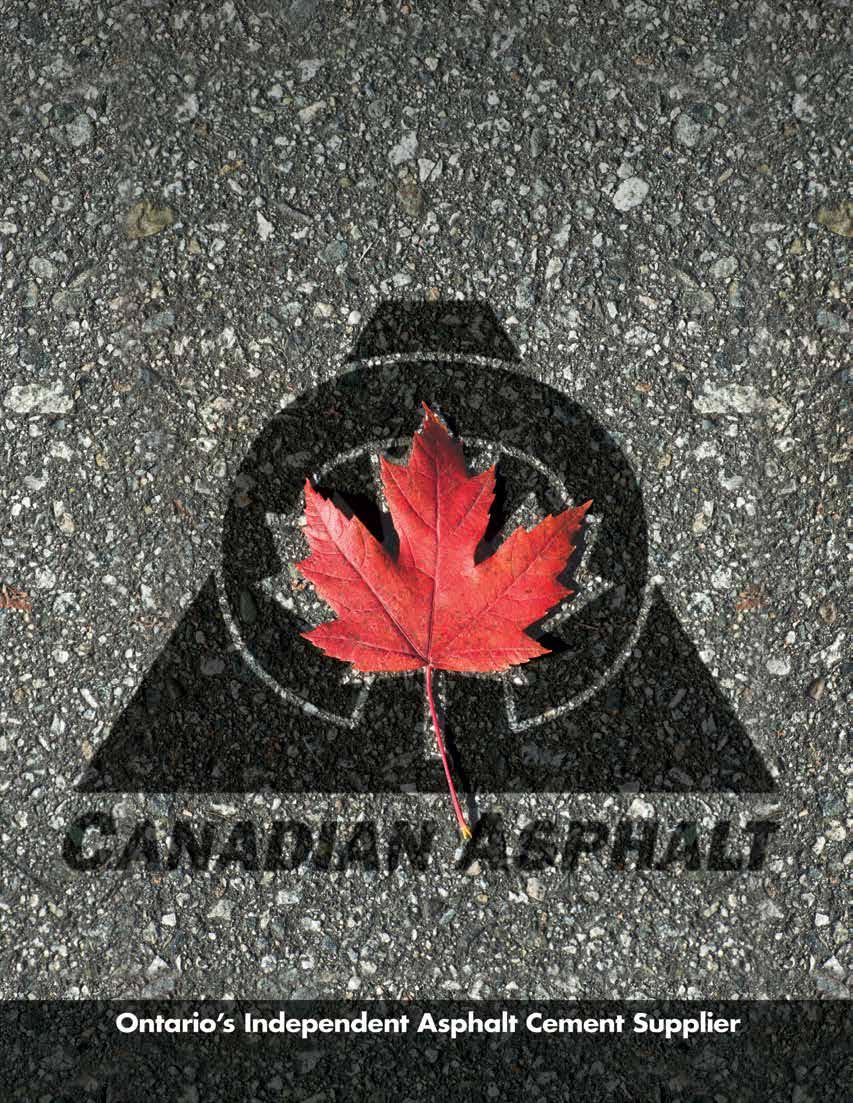

































 by Amin Mneina
by Amin Mneina

















 by Sina Varamini
by Sina Varamini















 by Lara Henry
by Lara Henry





























